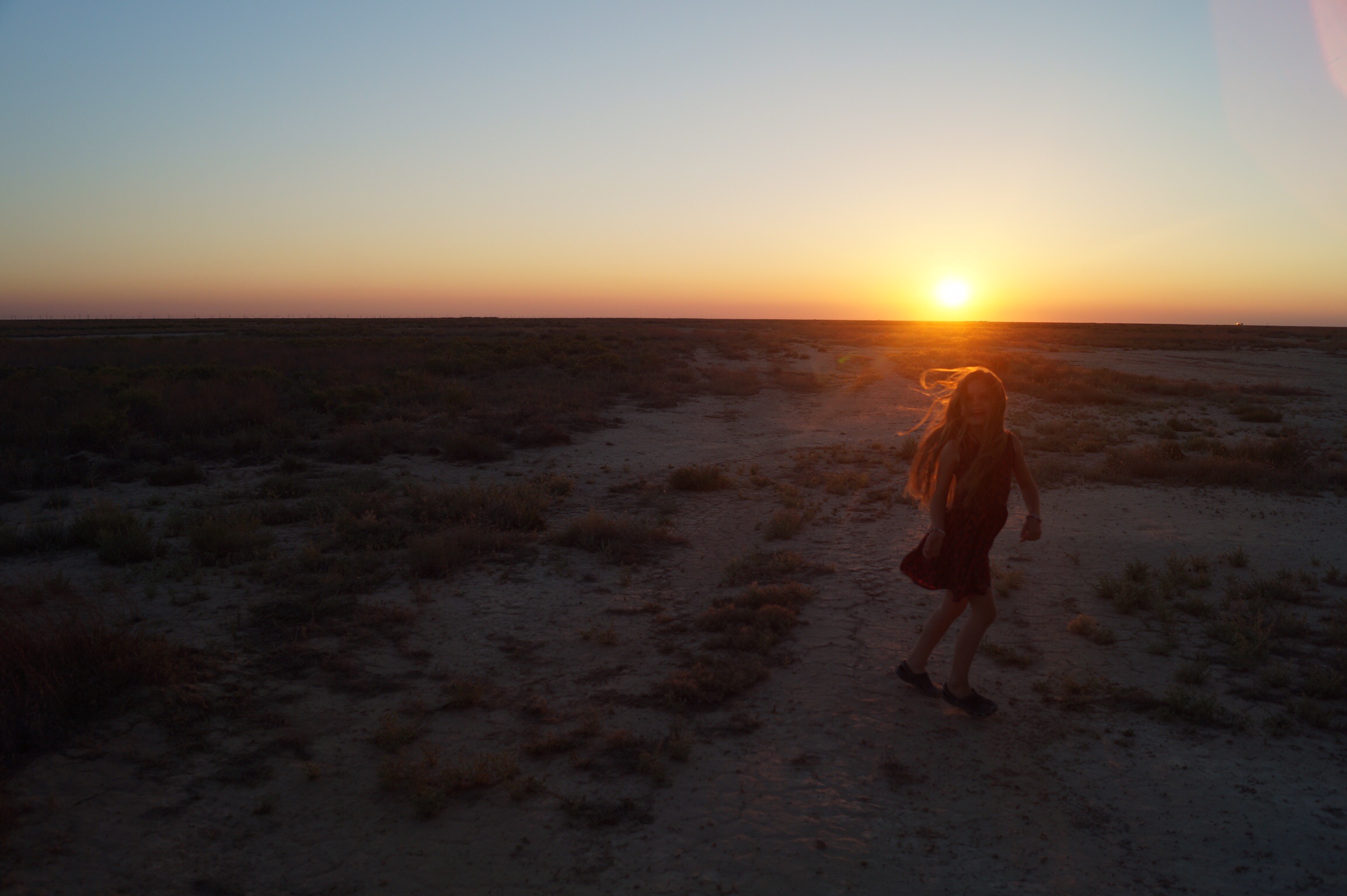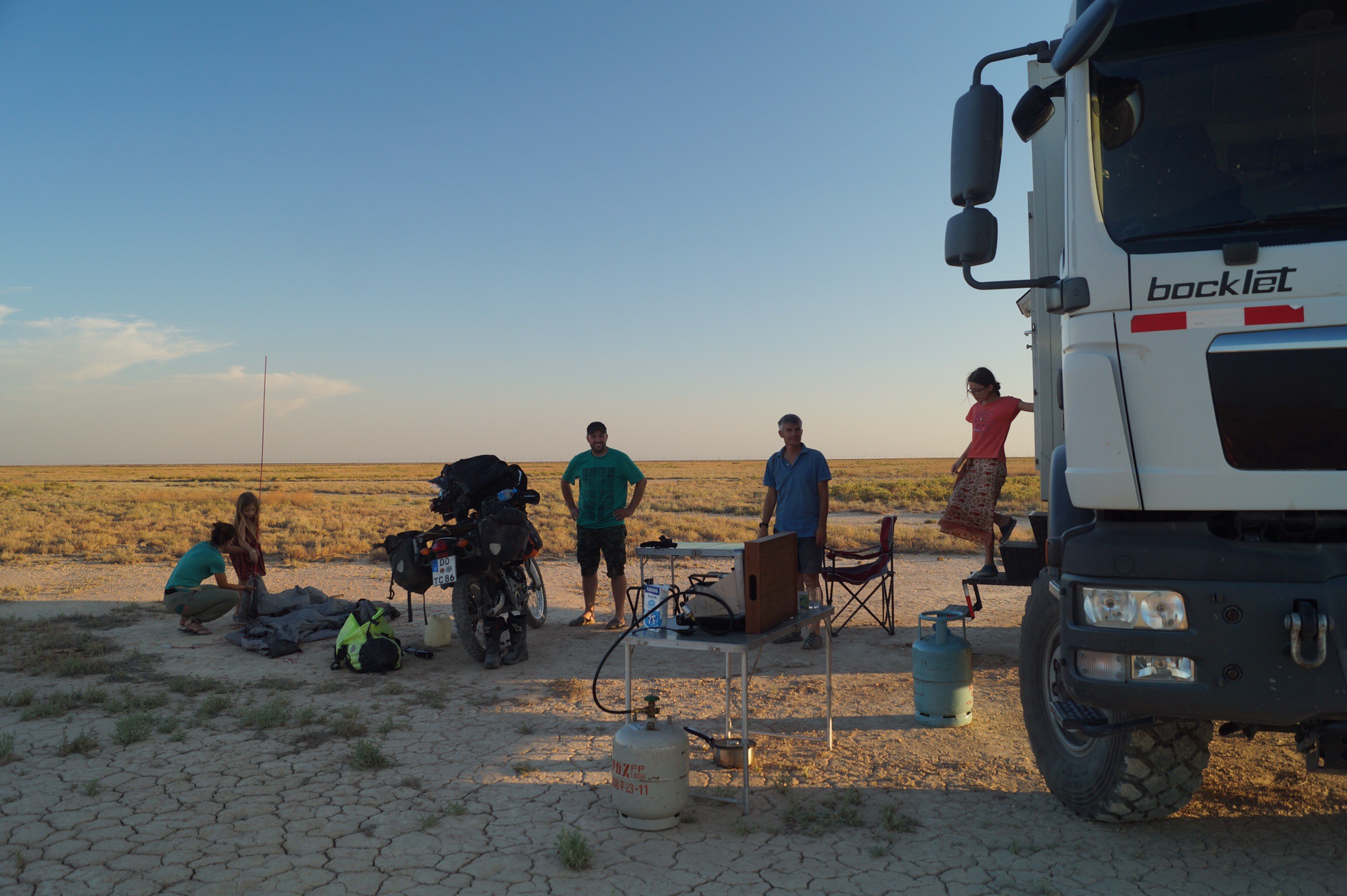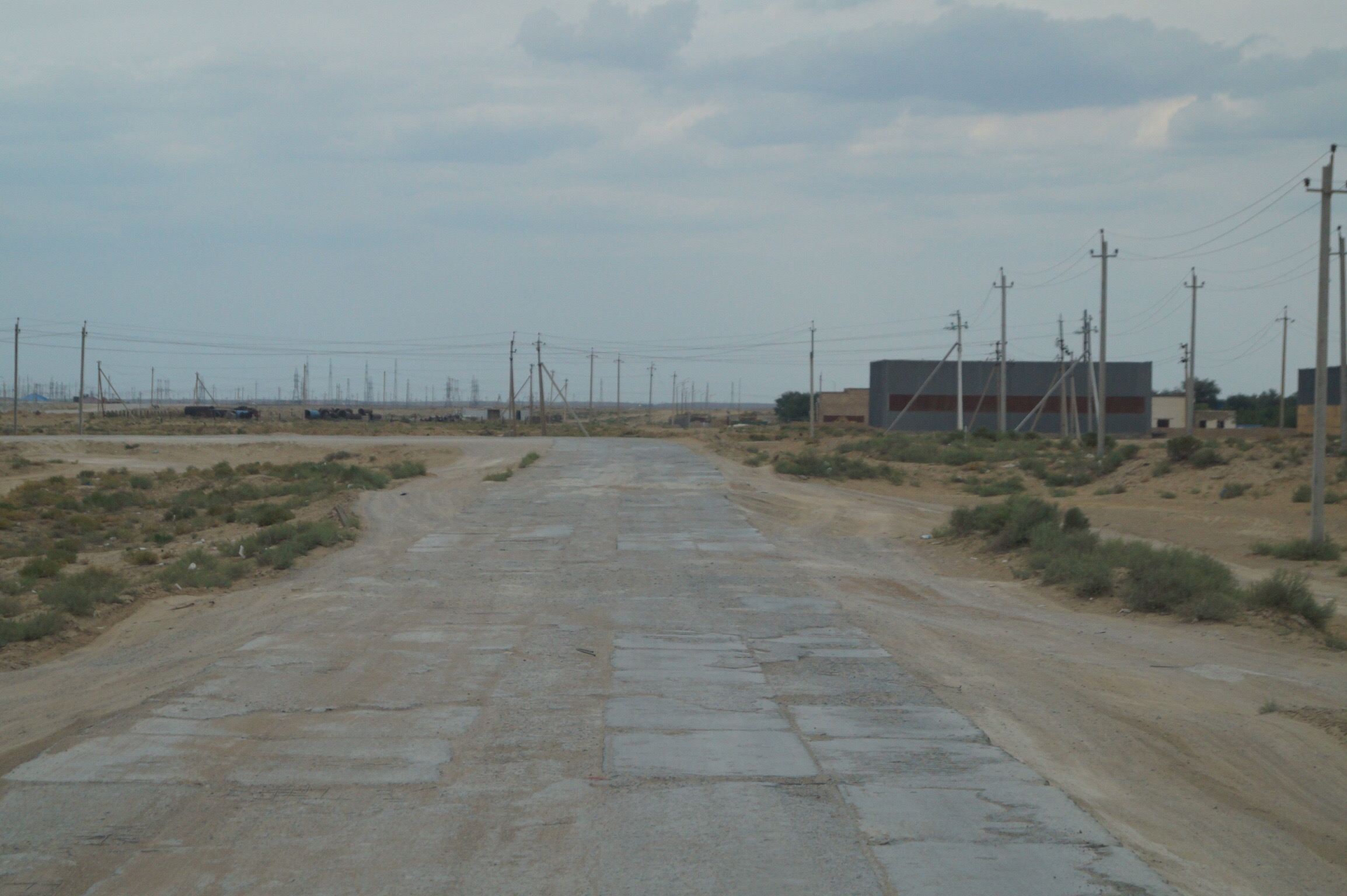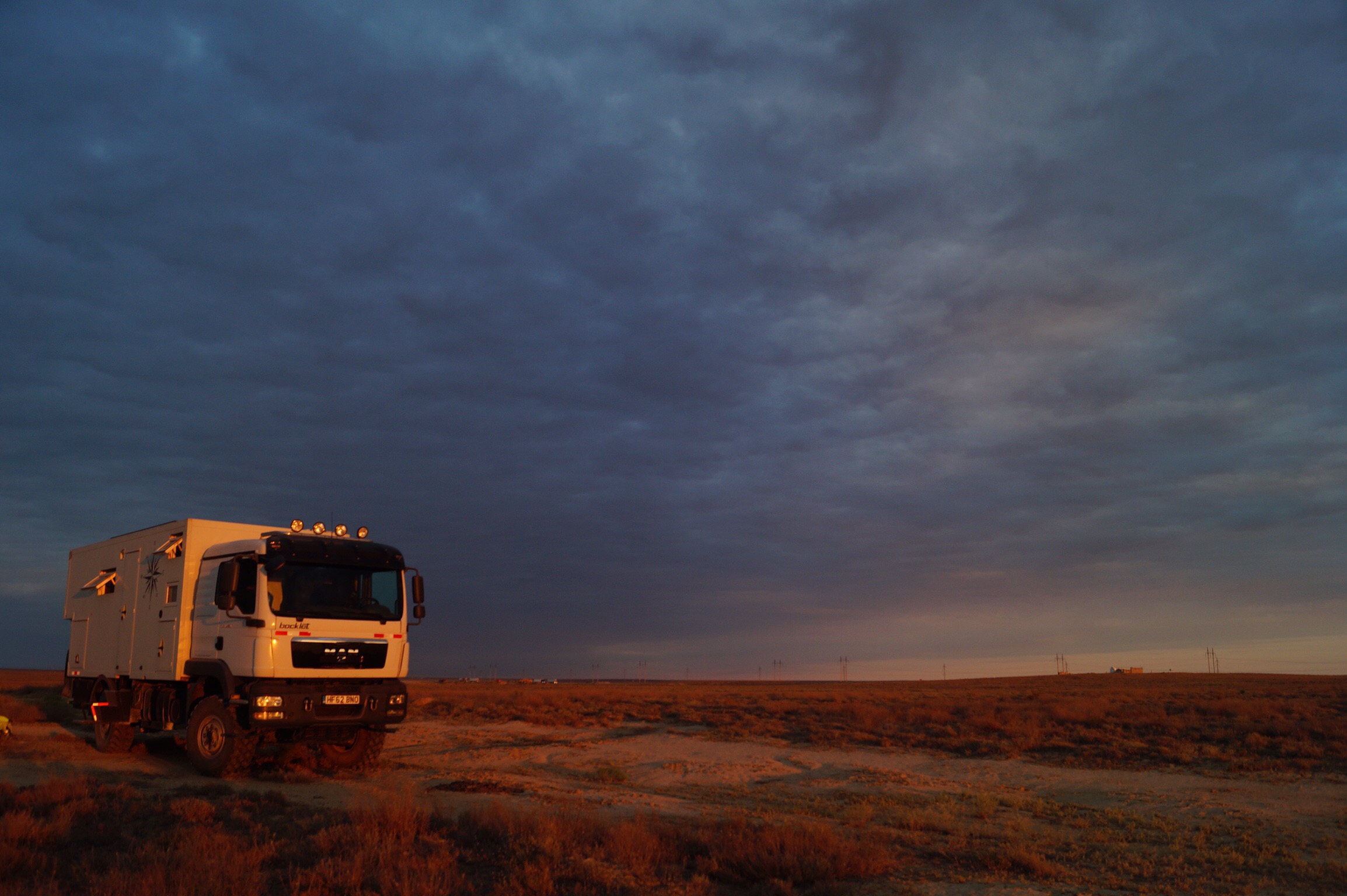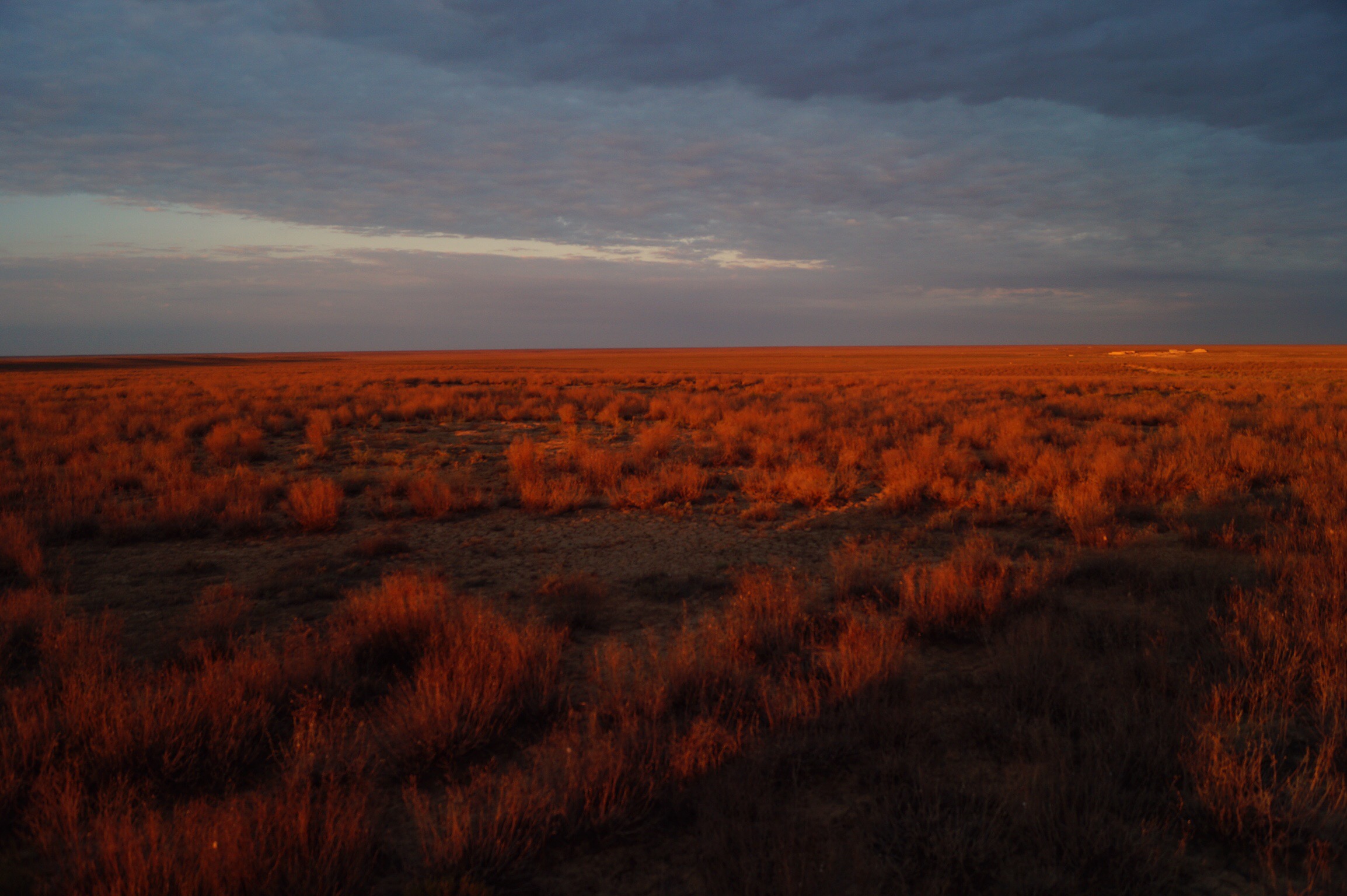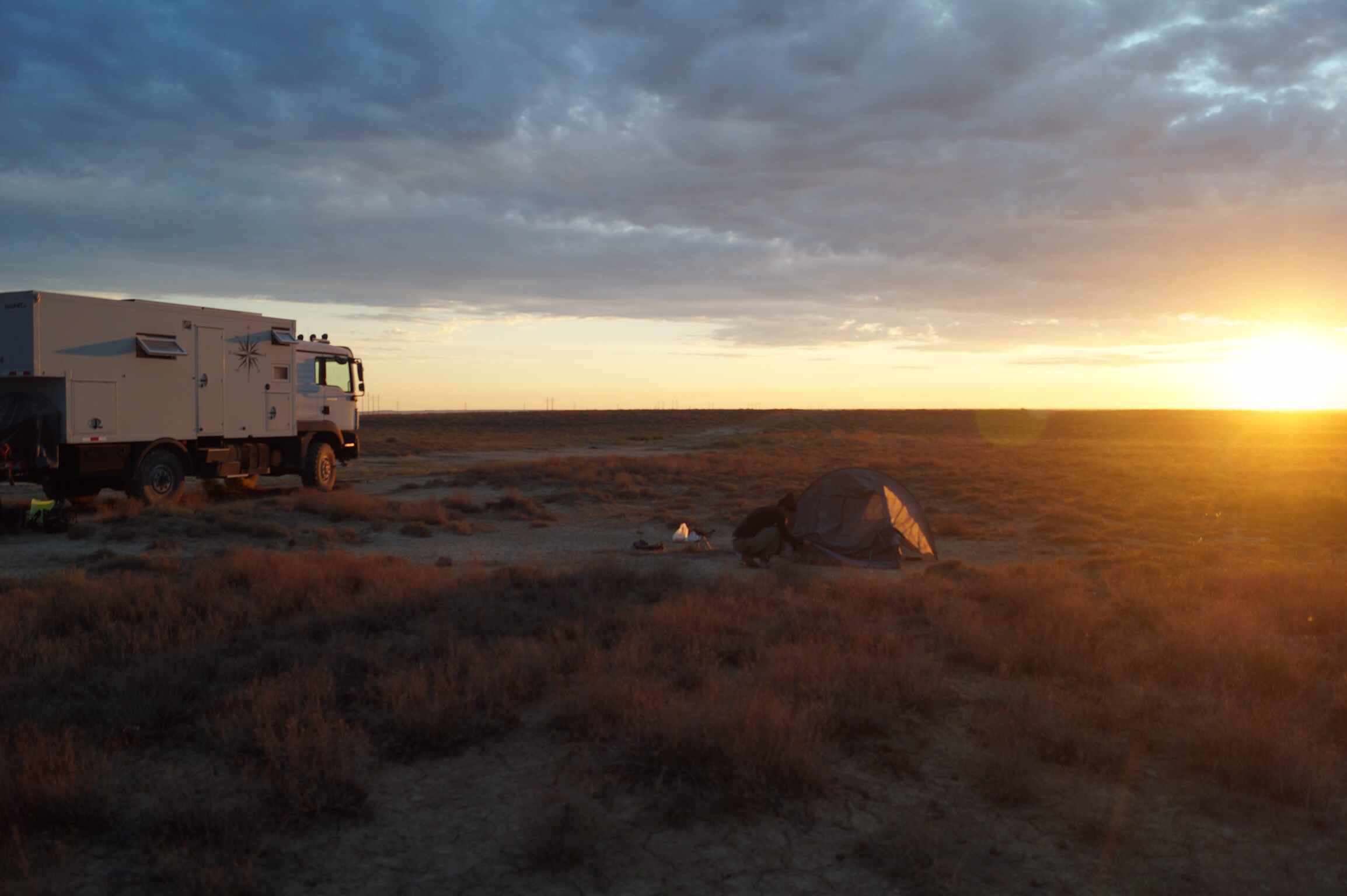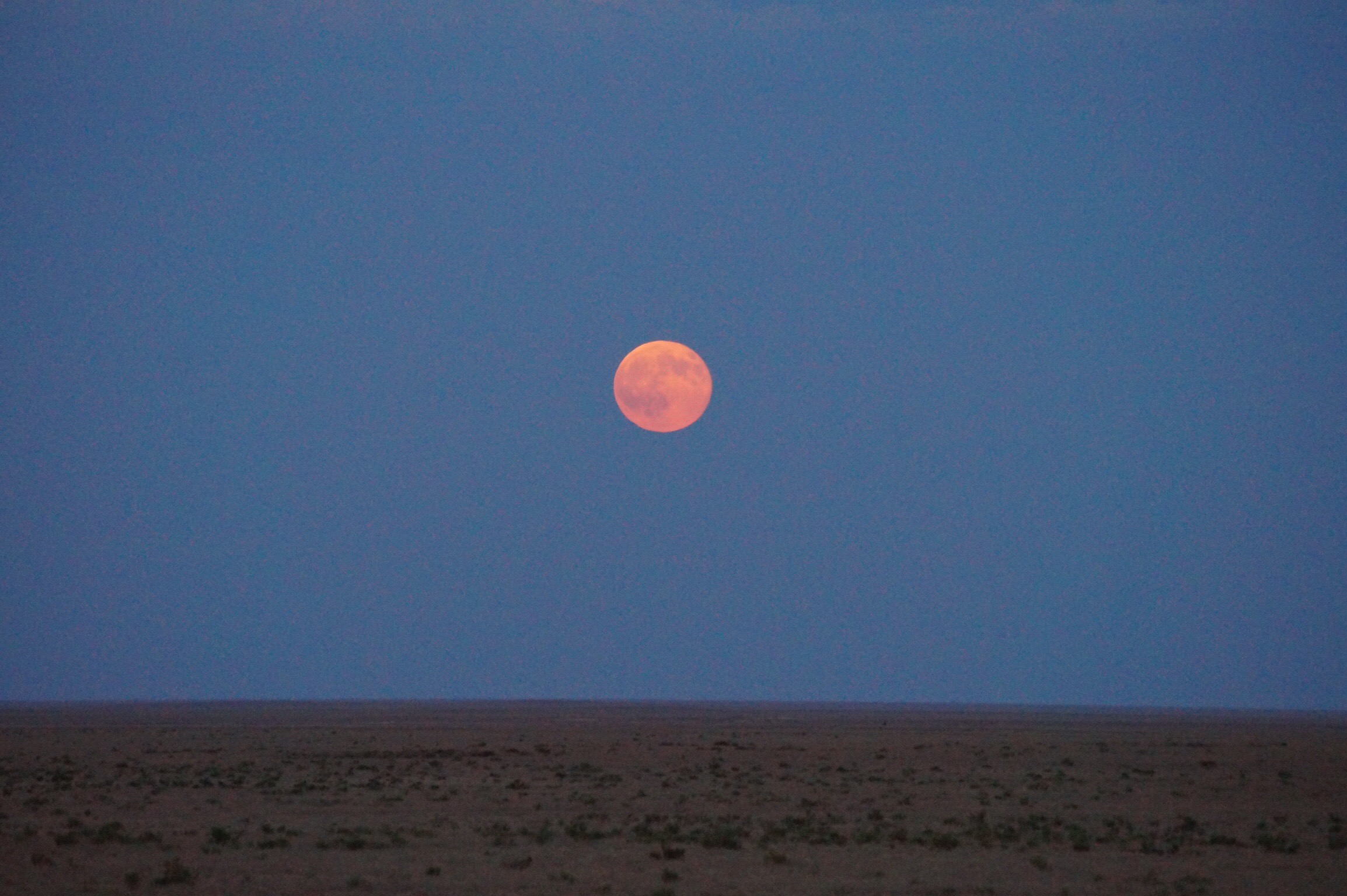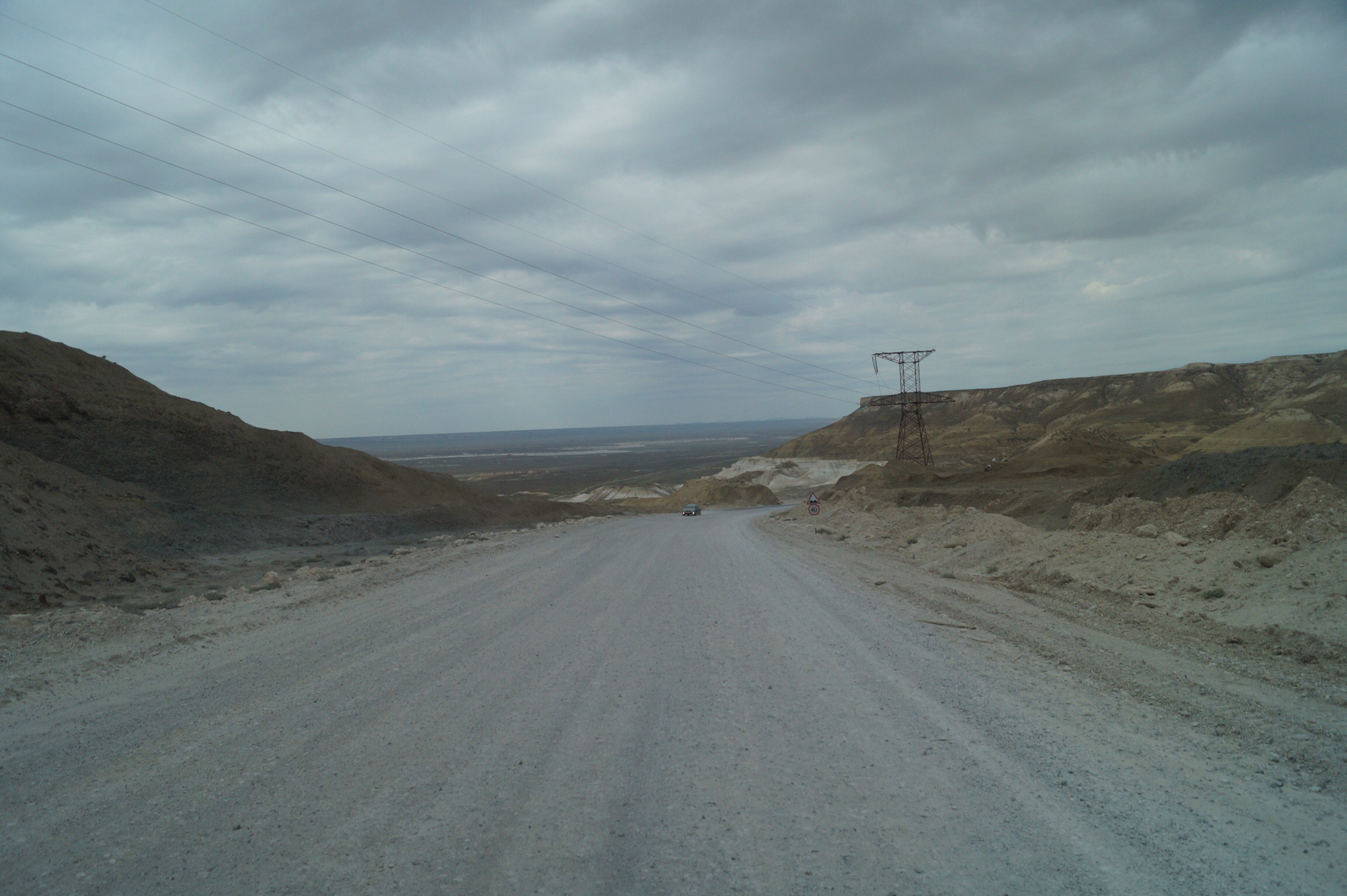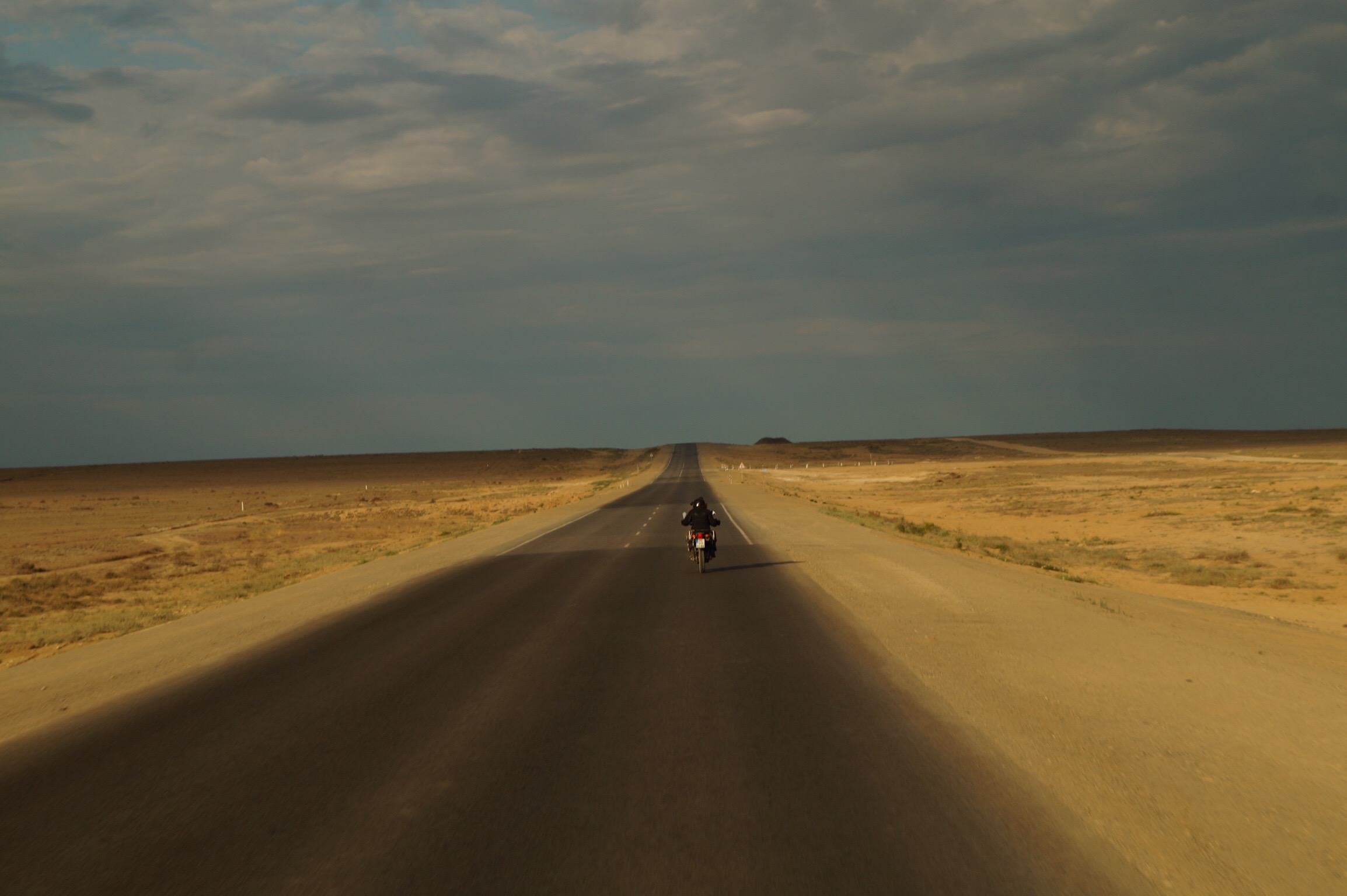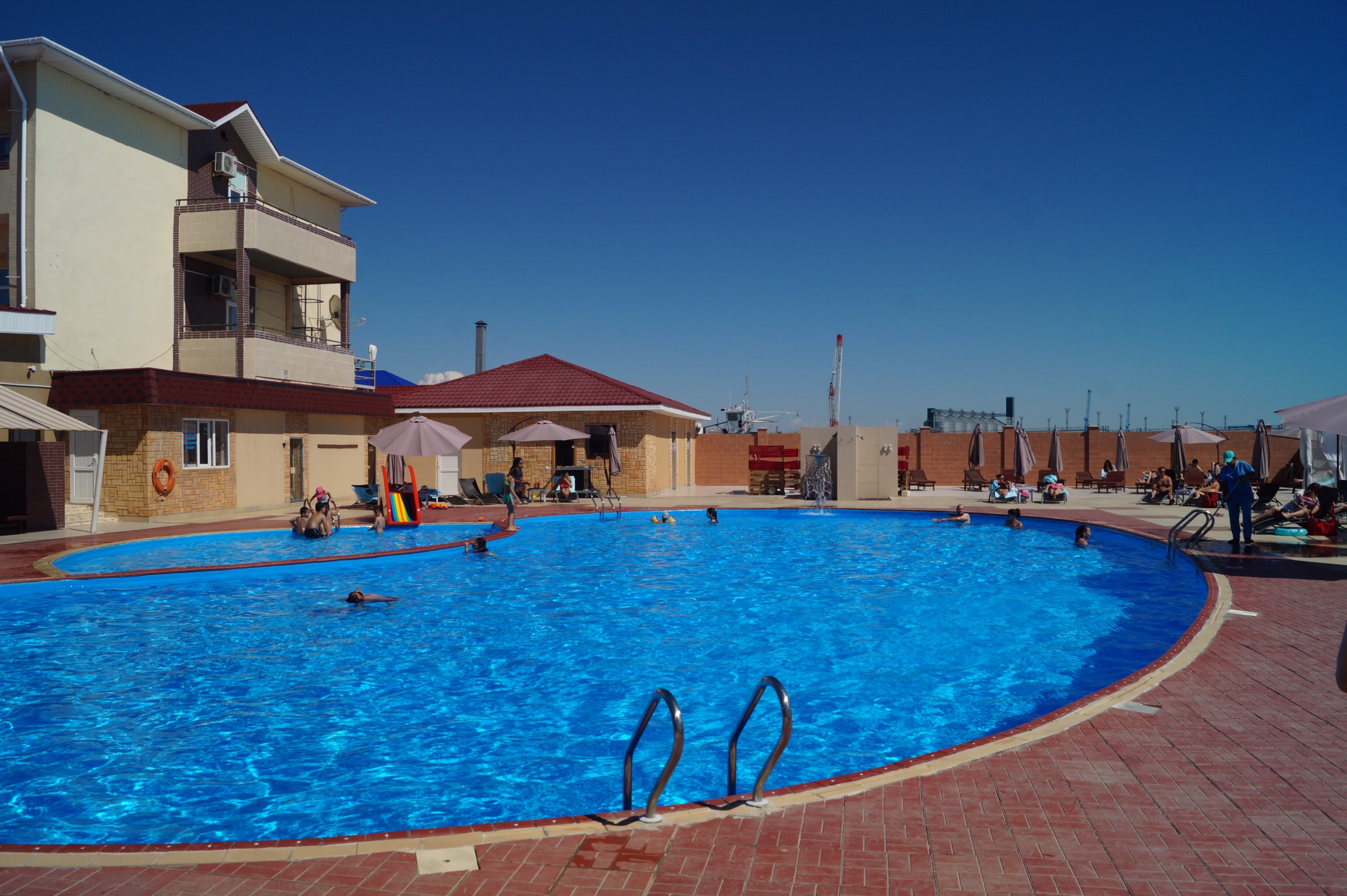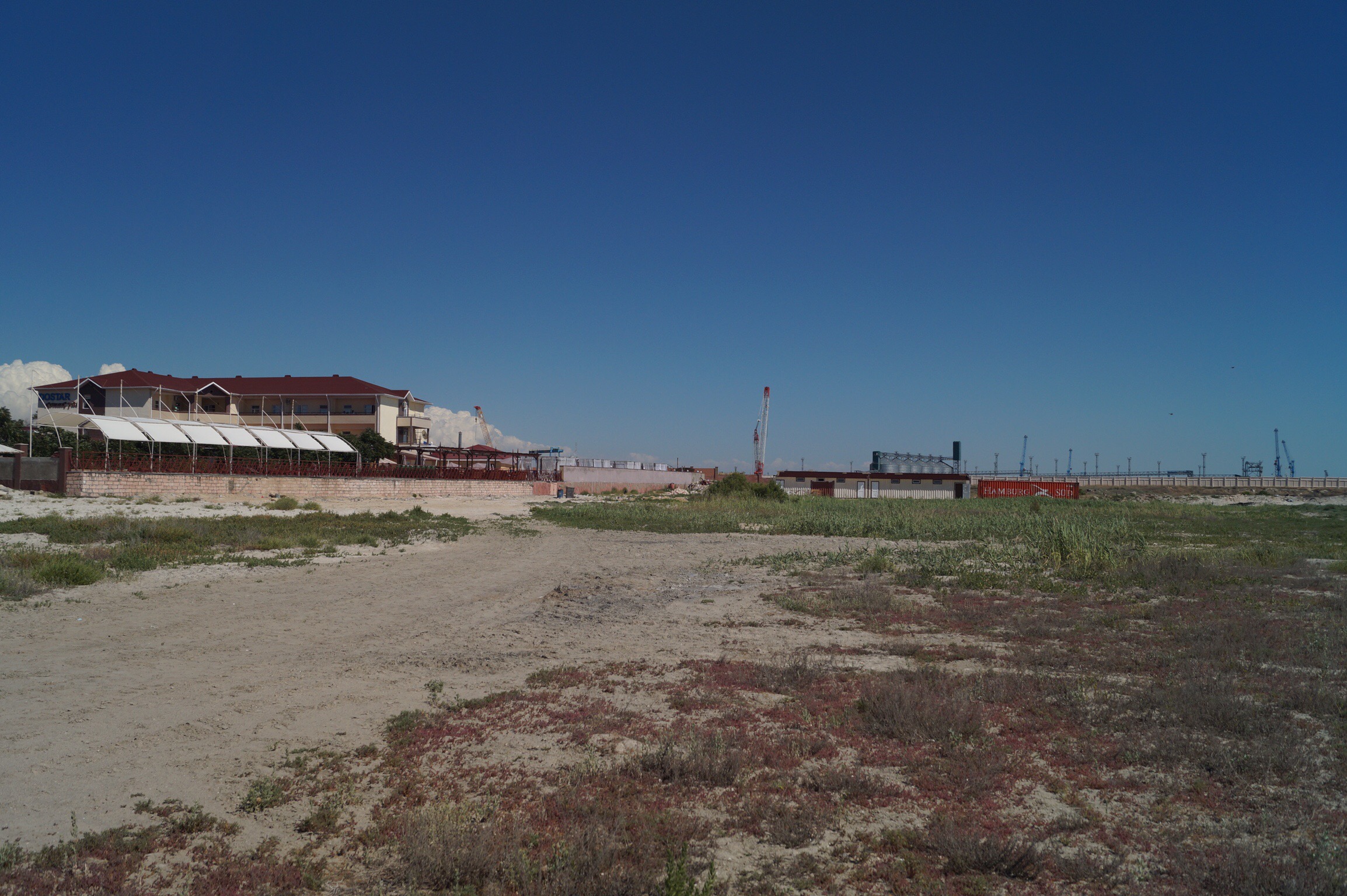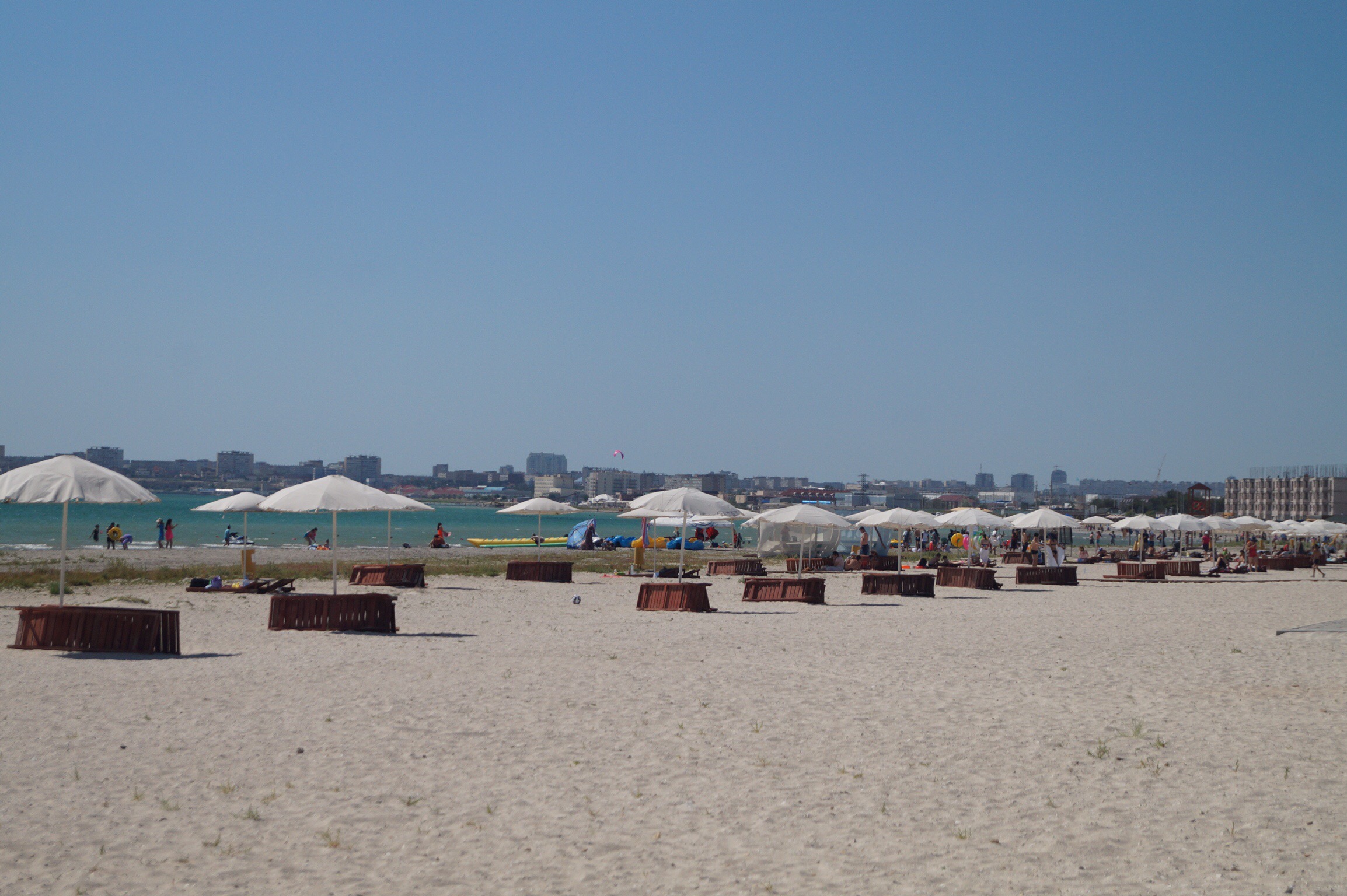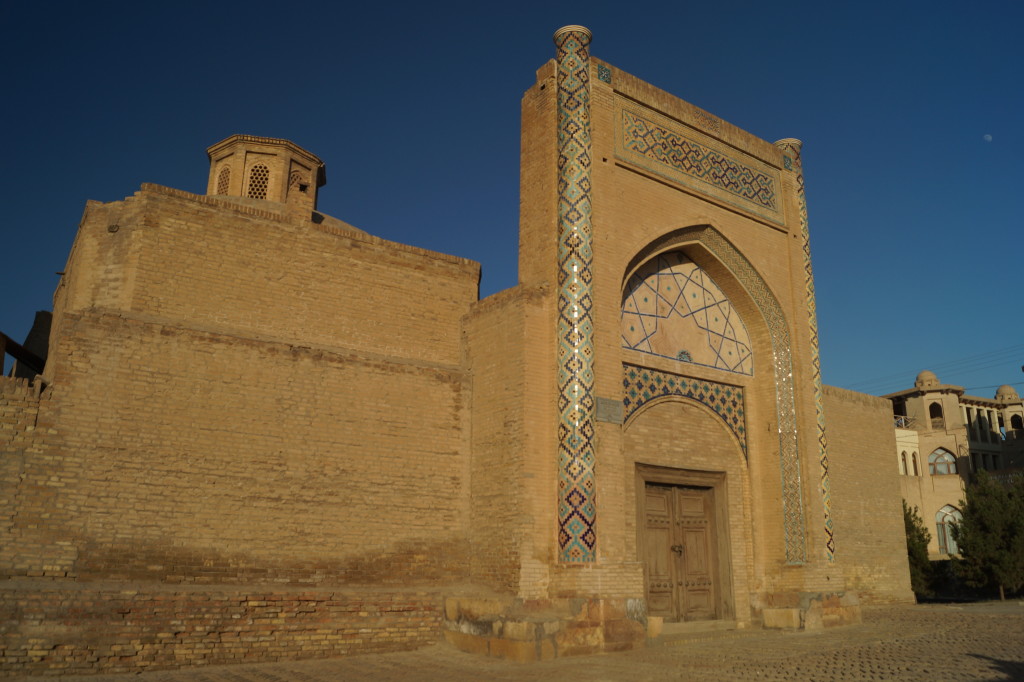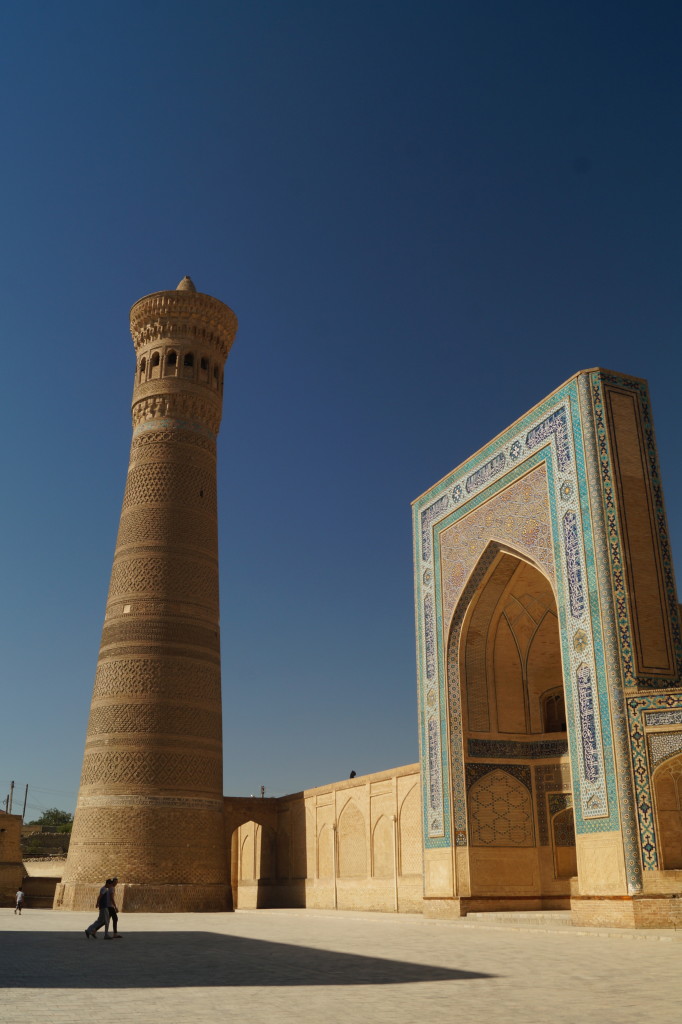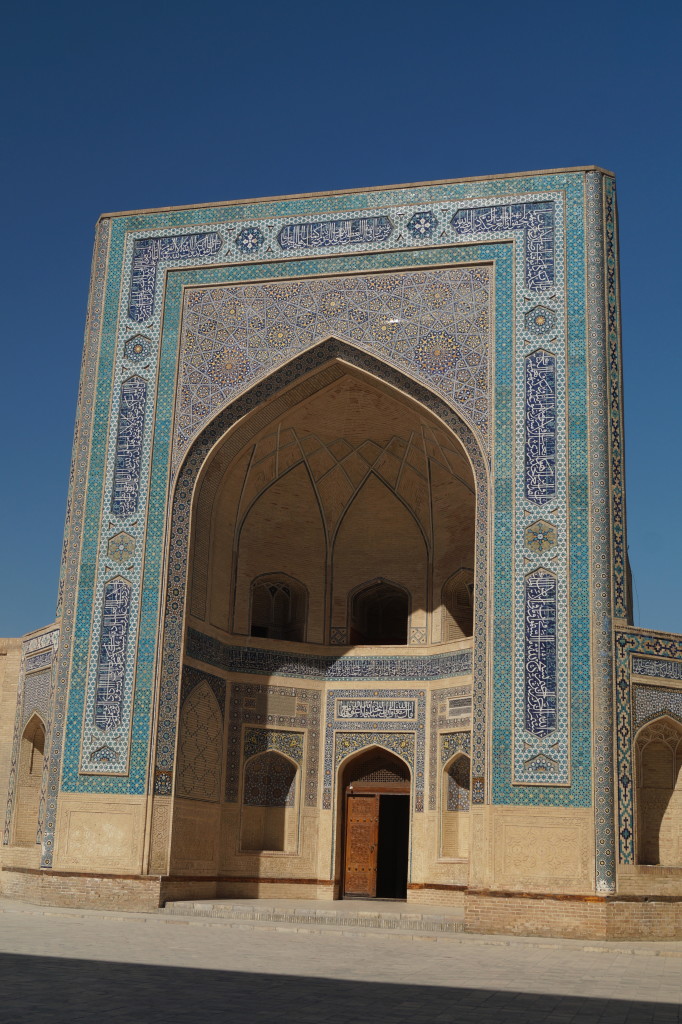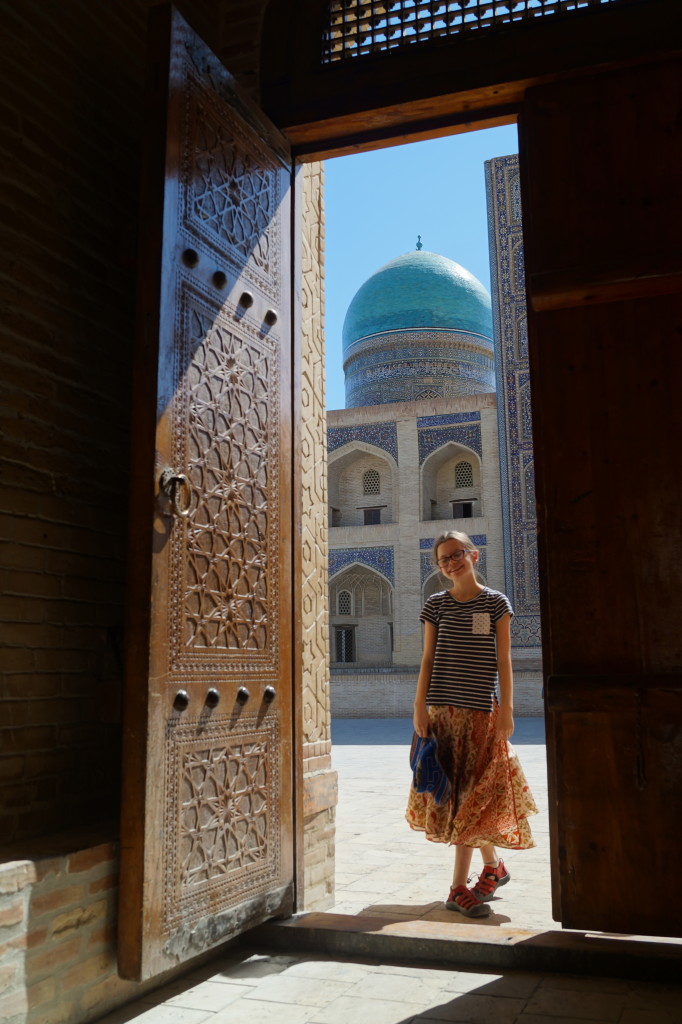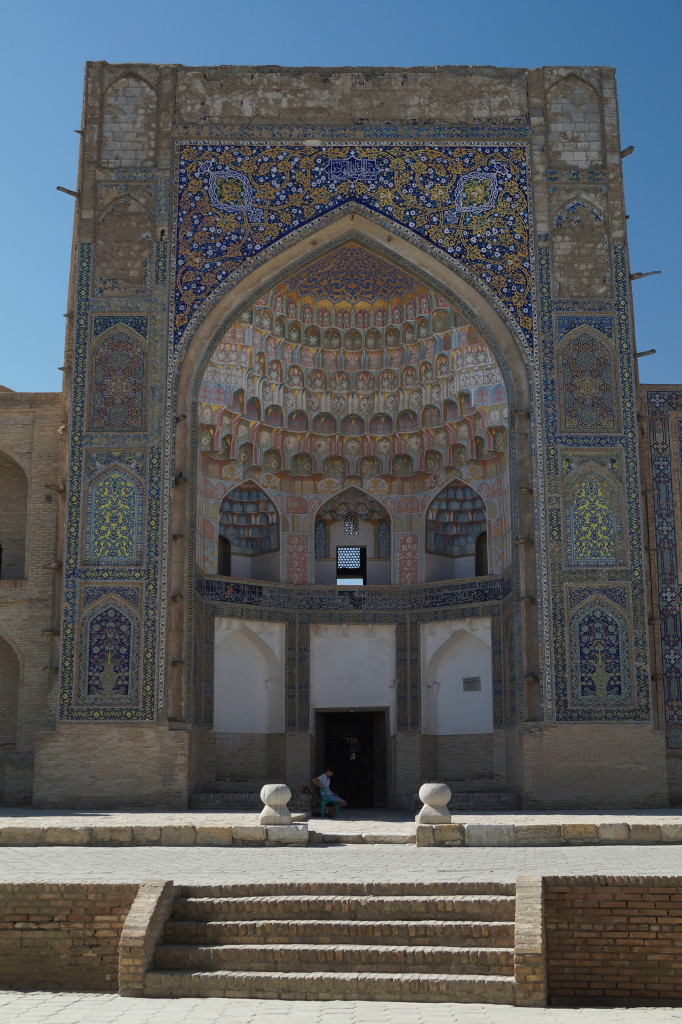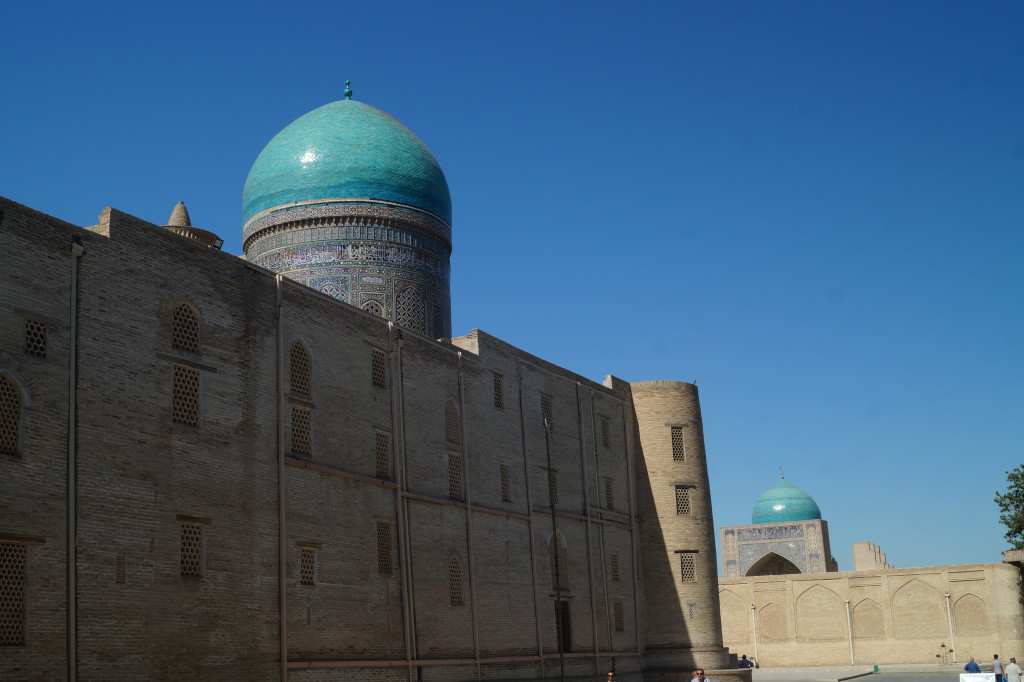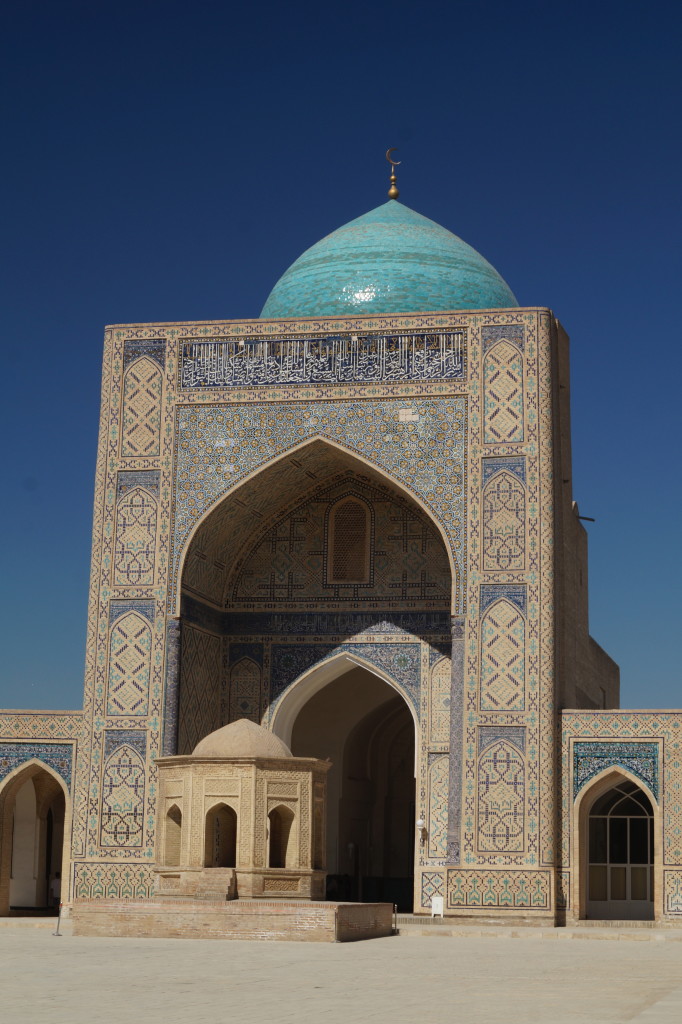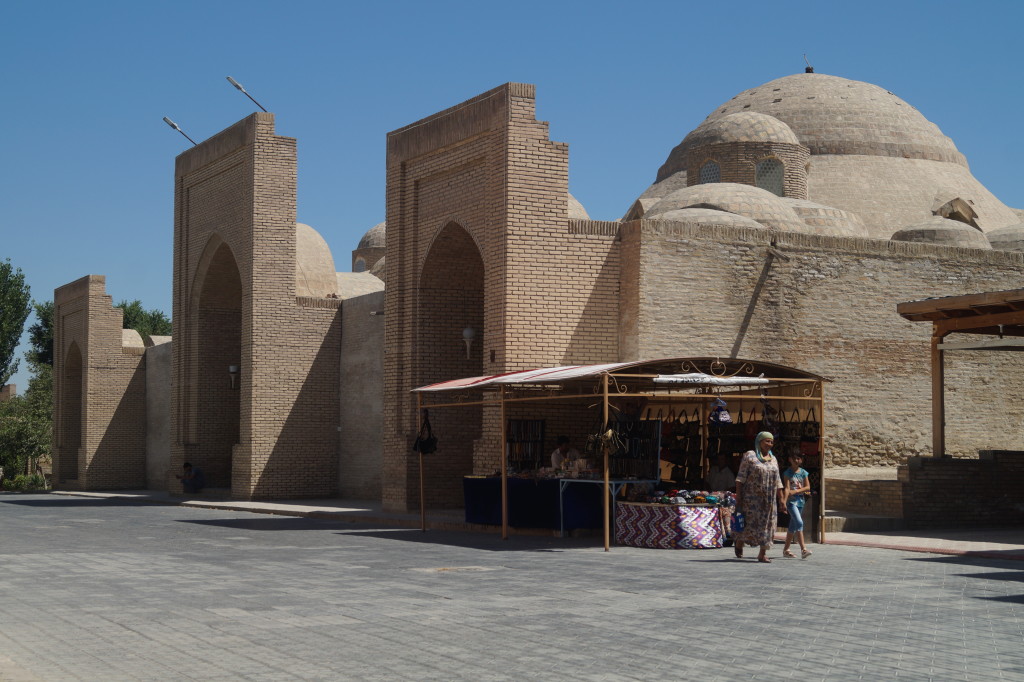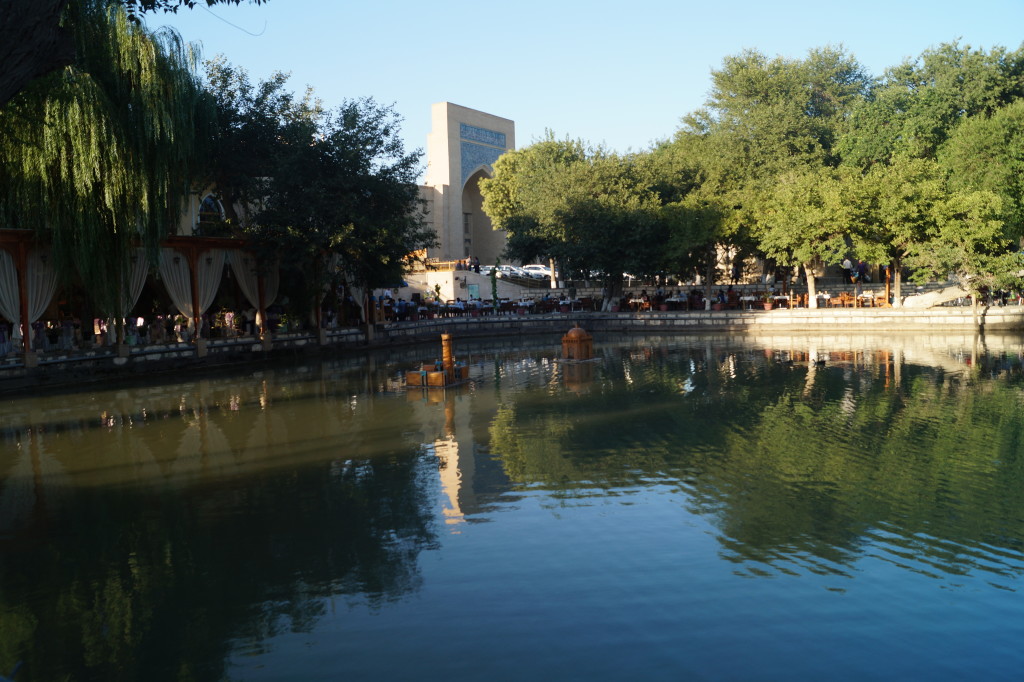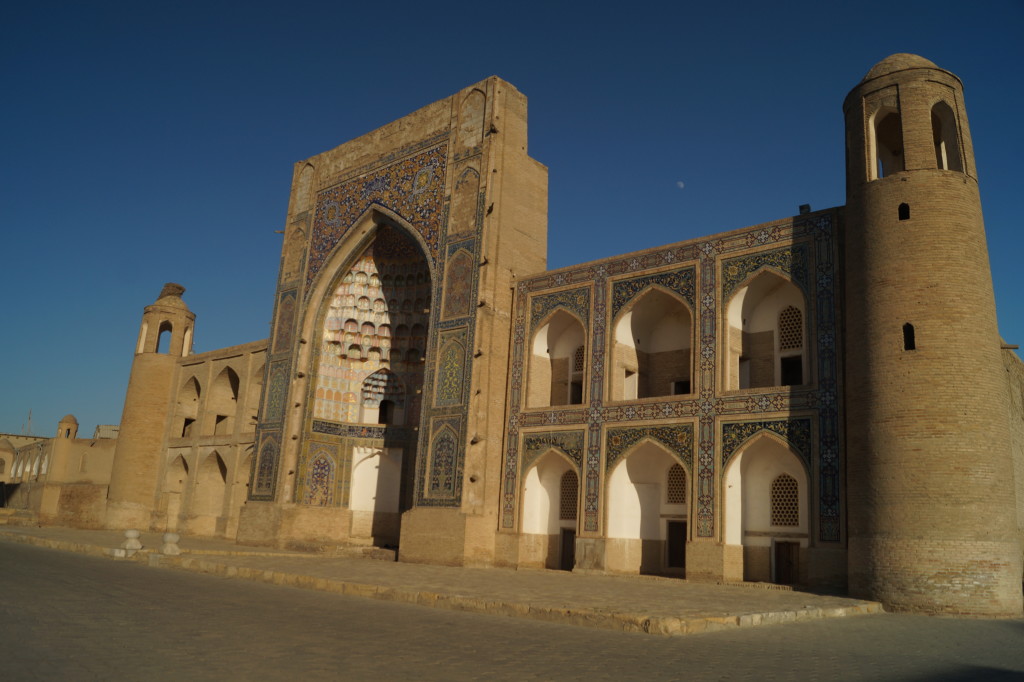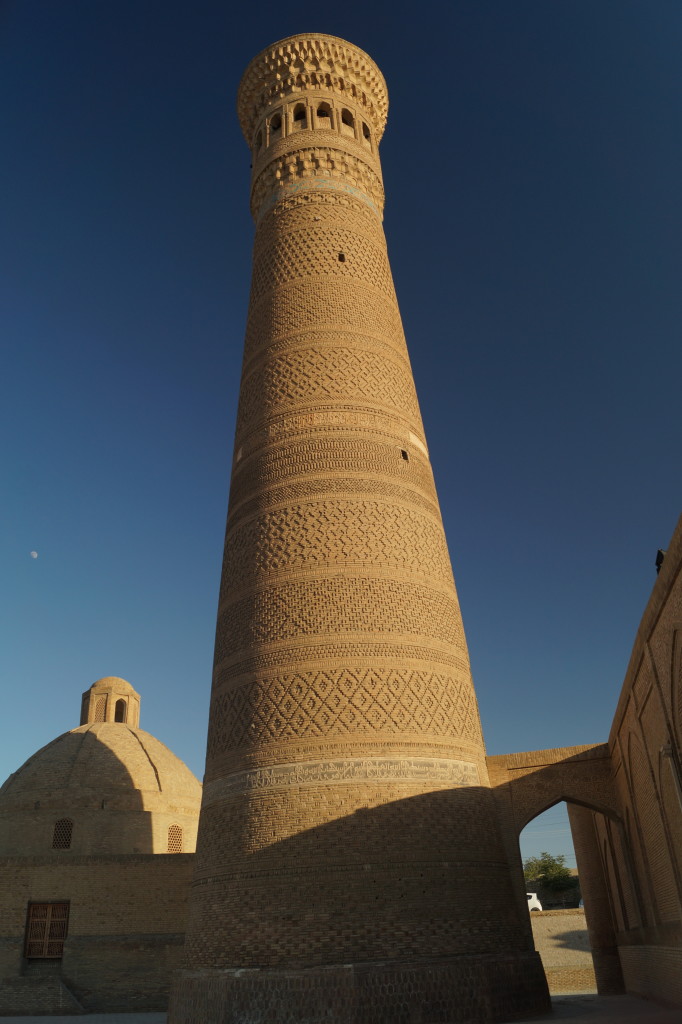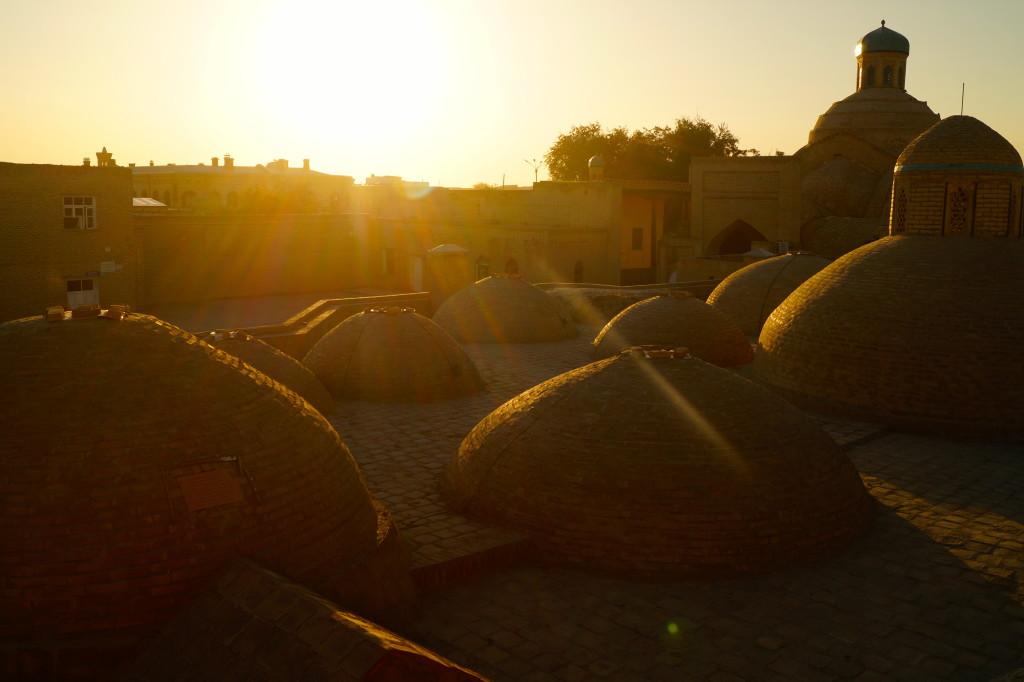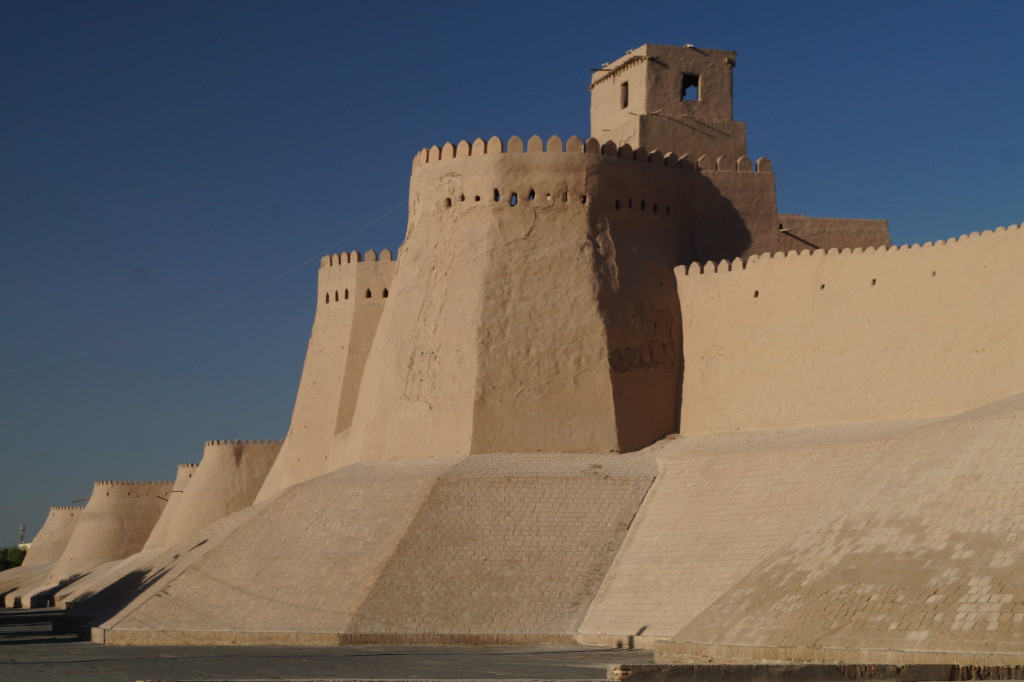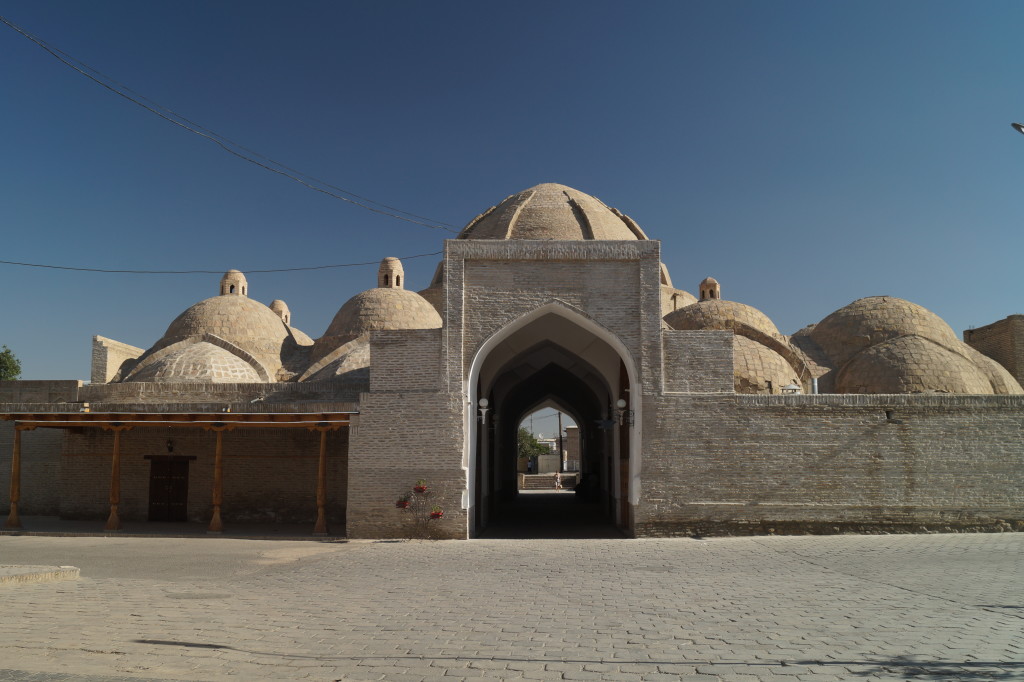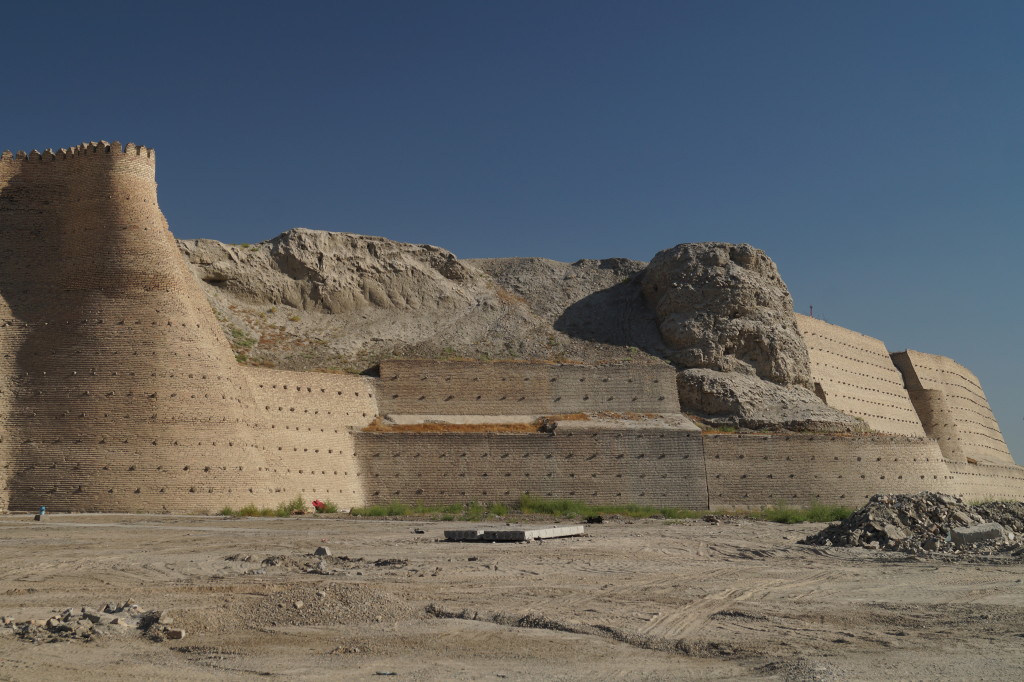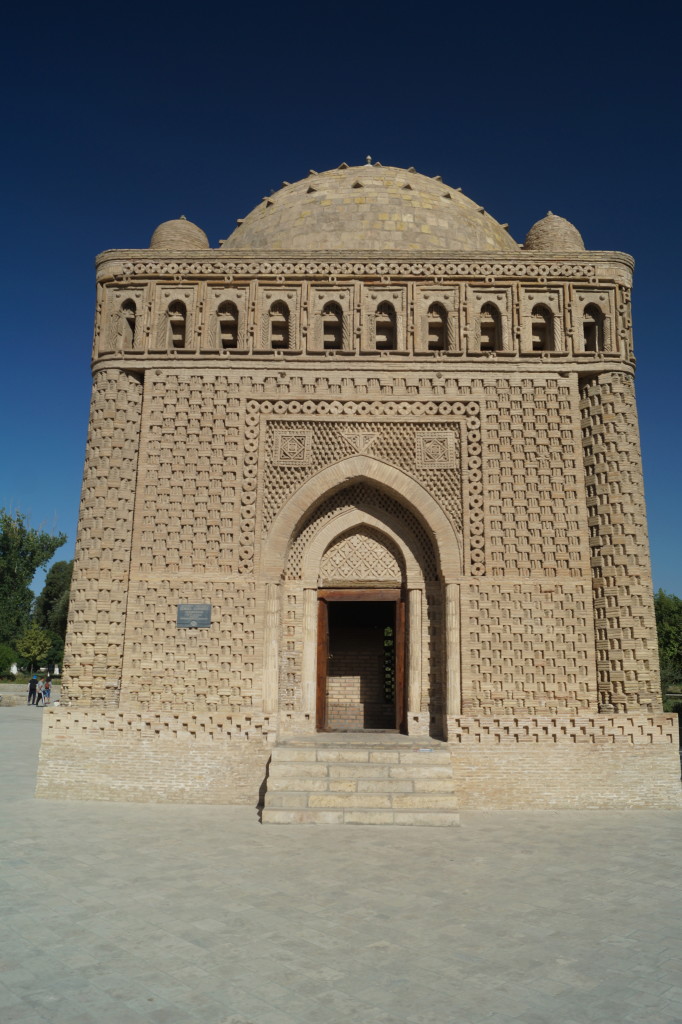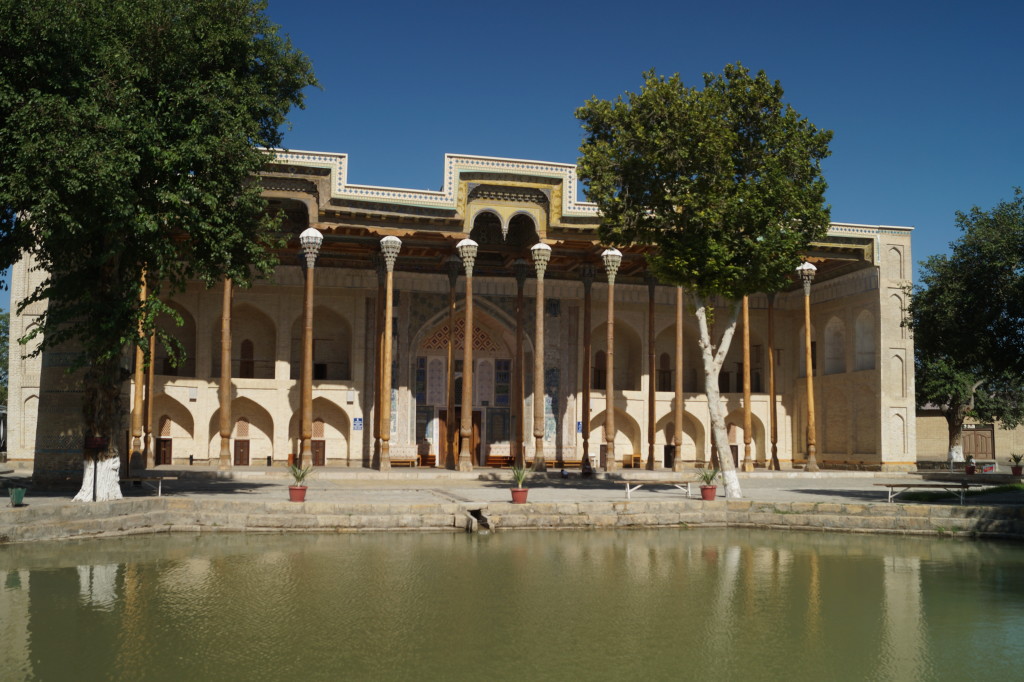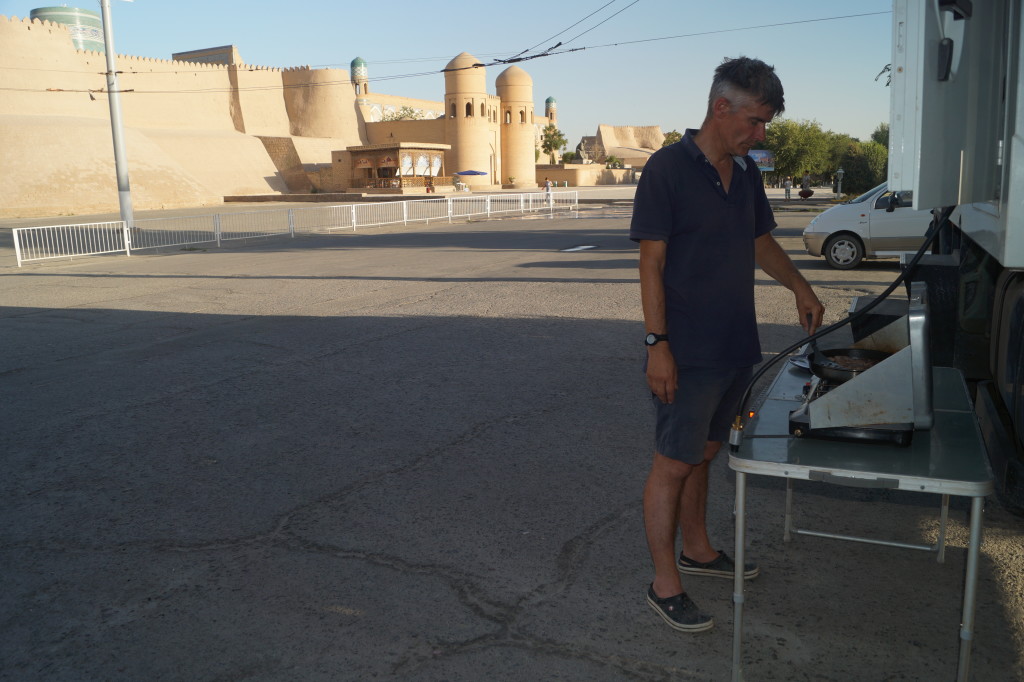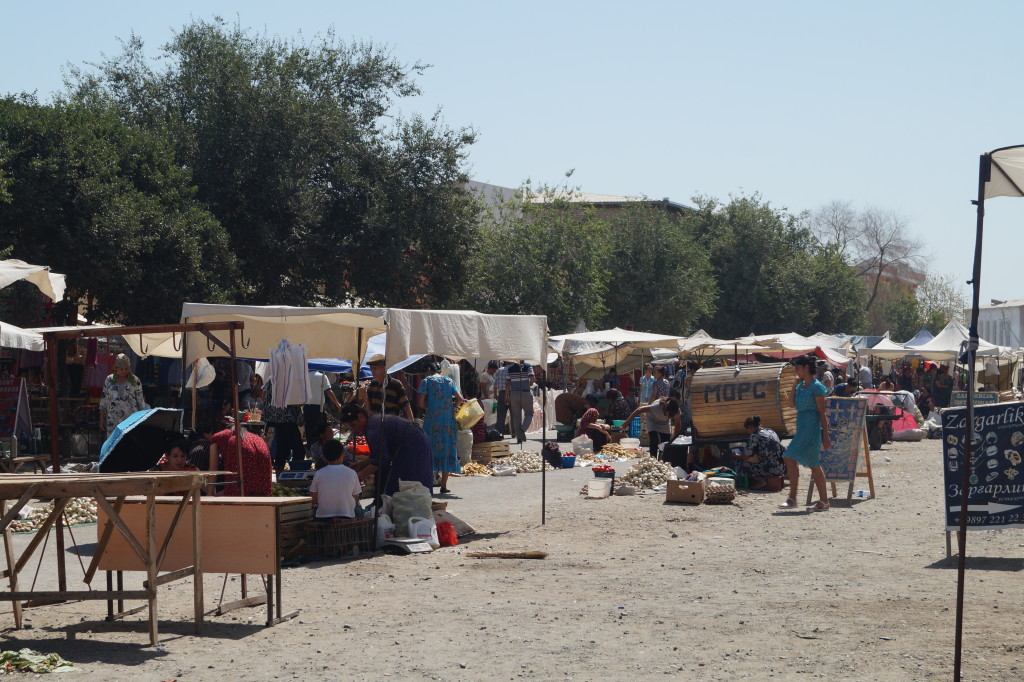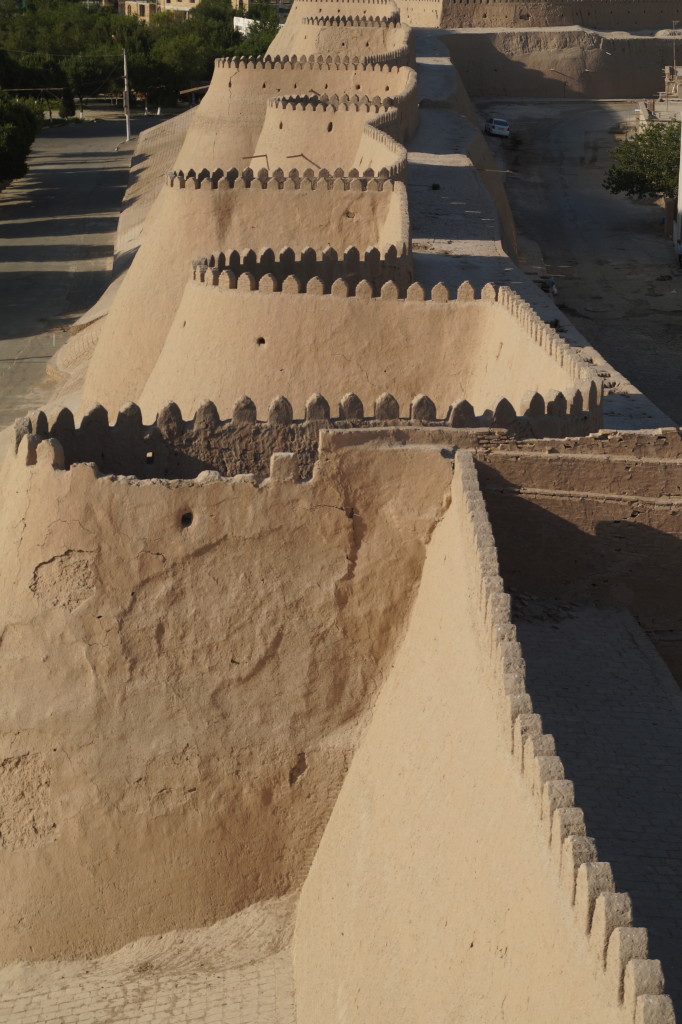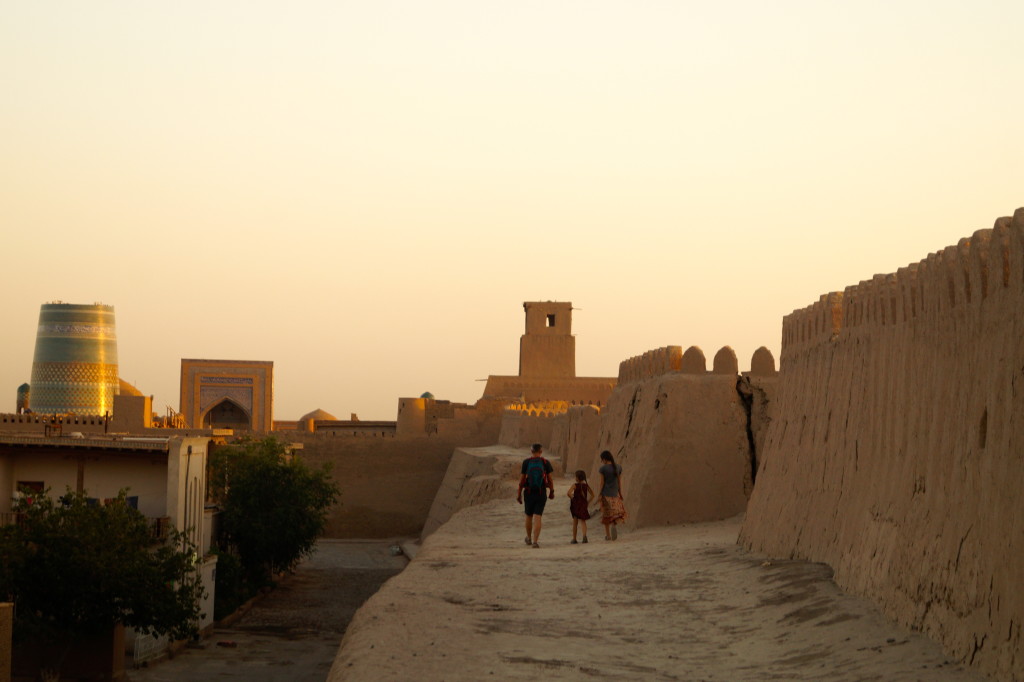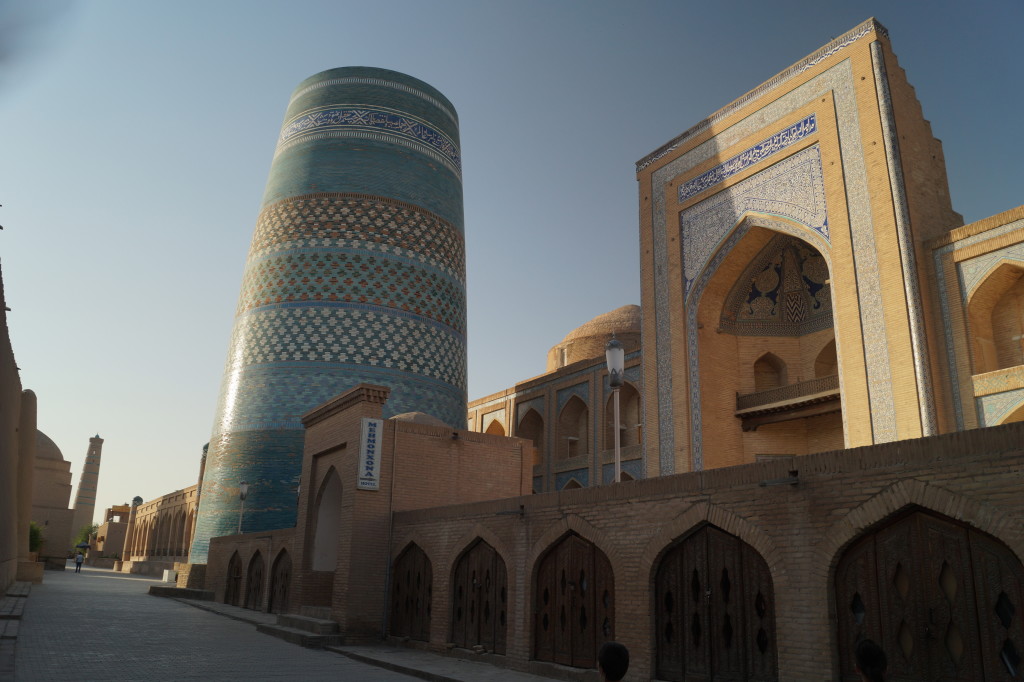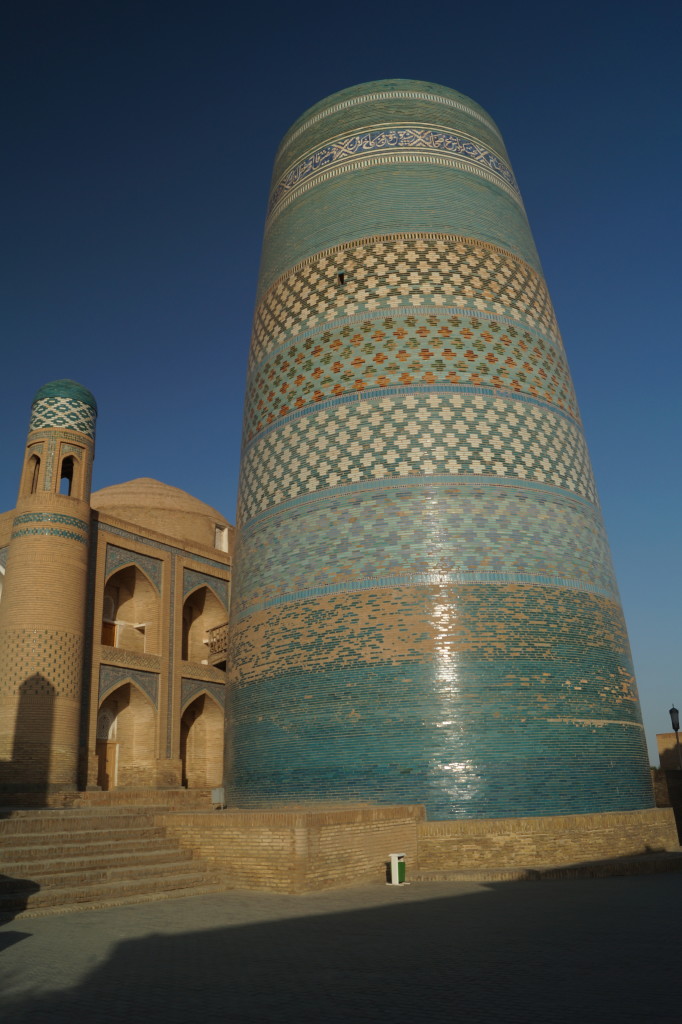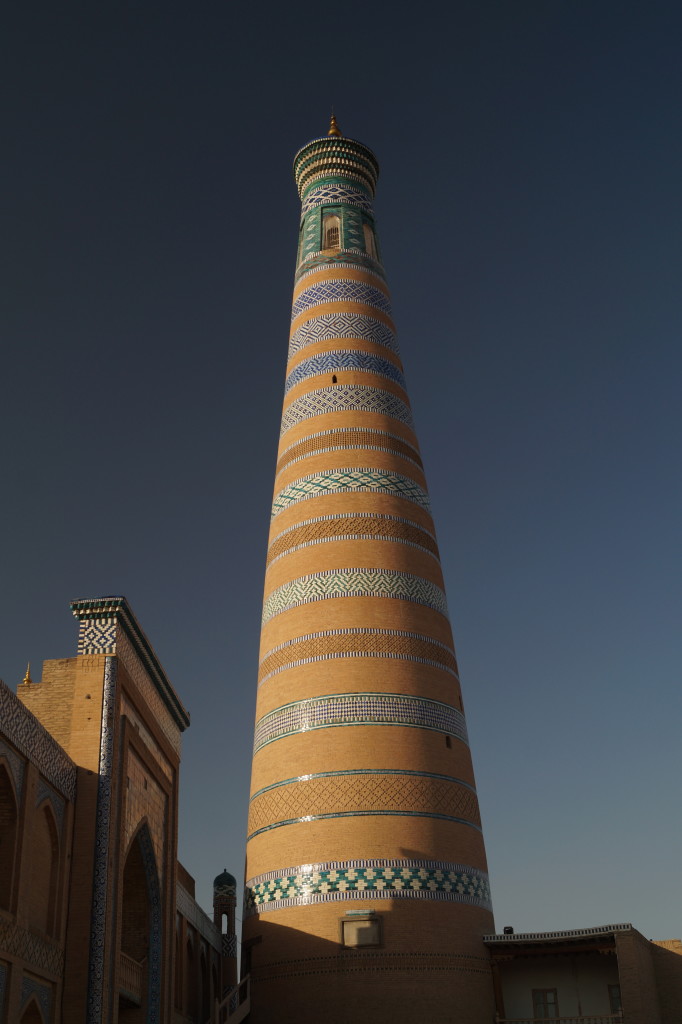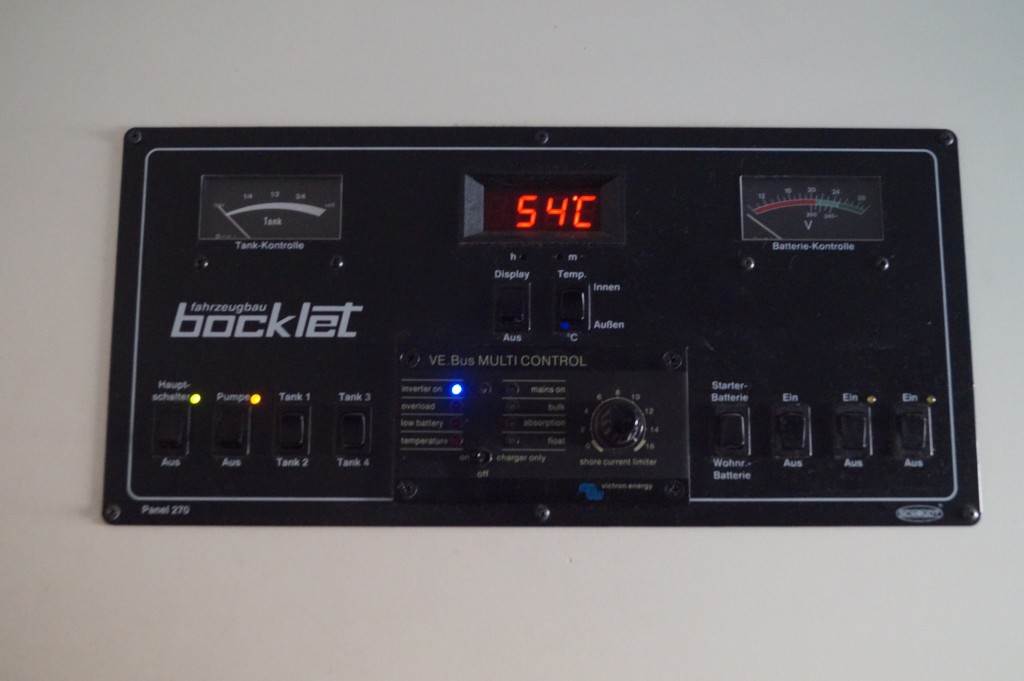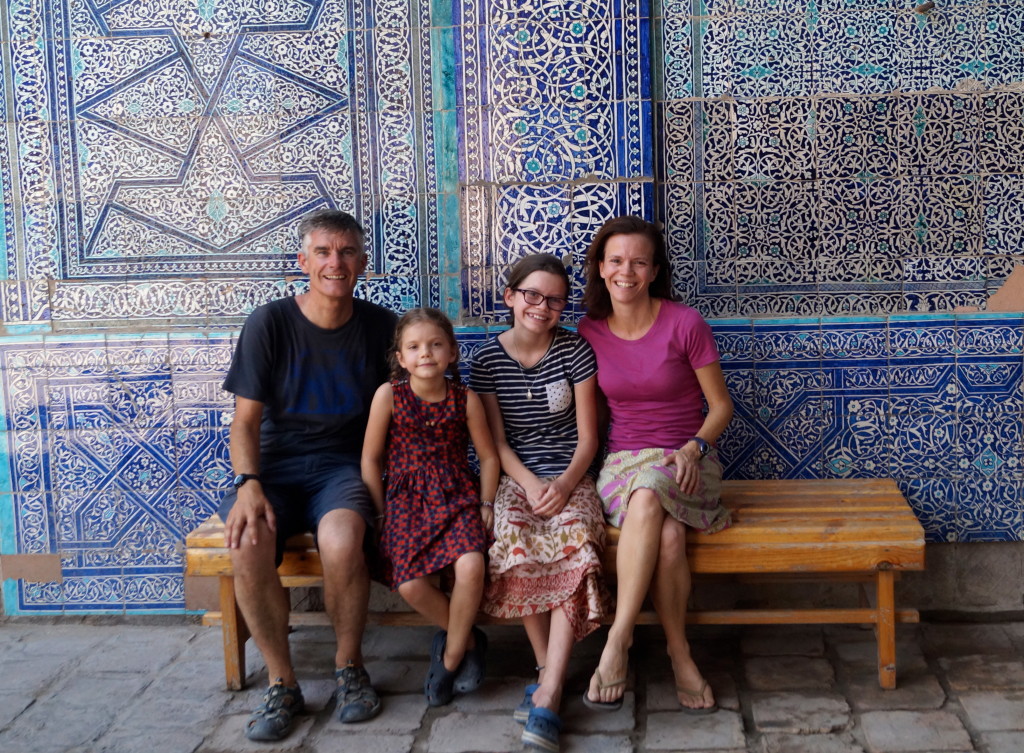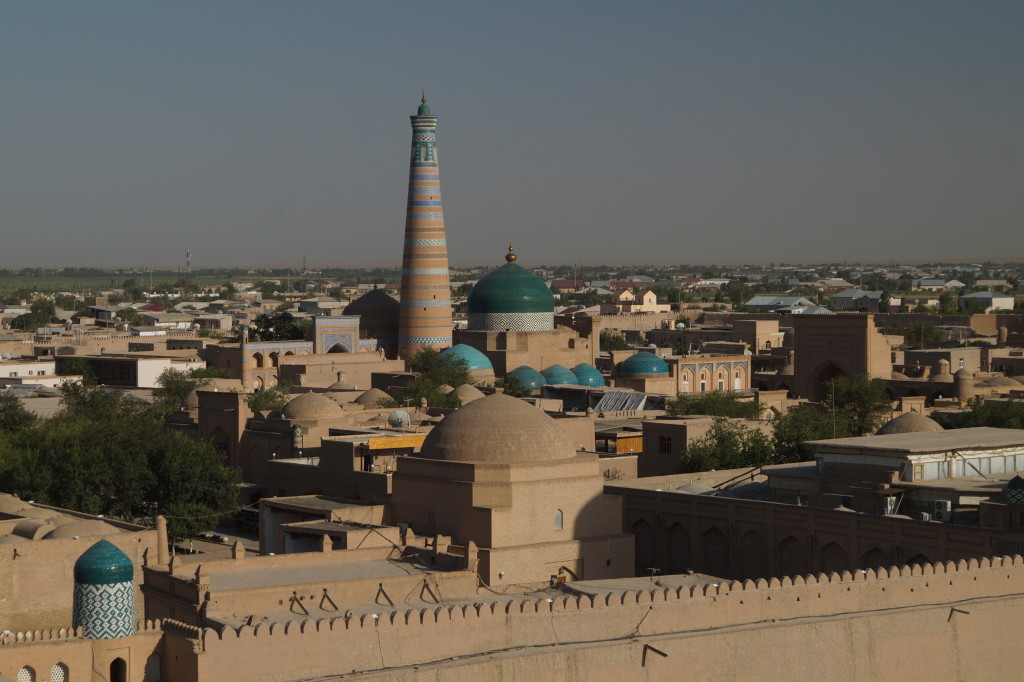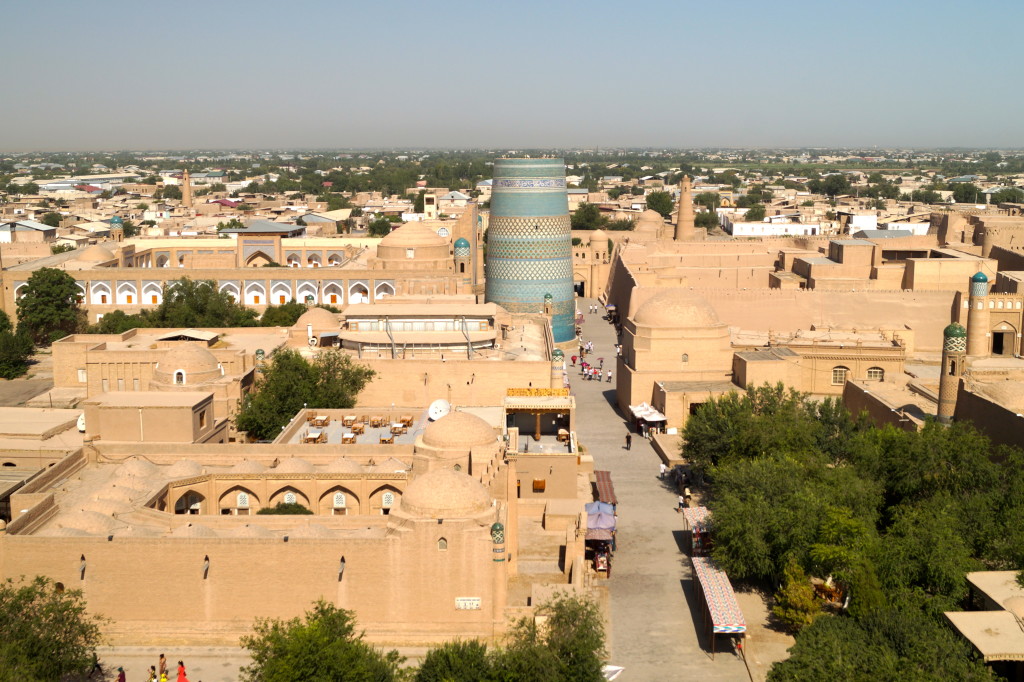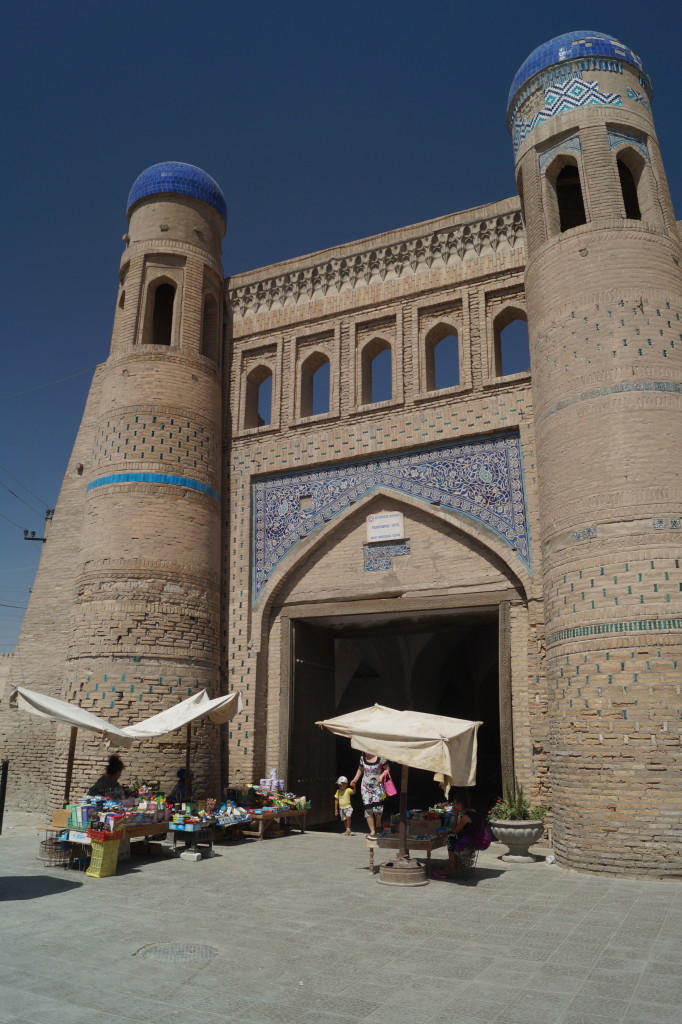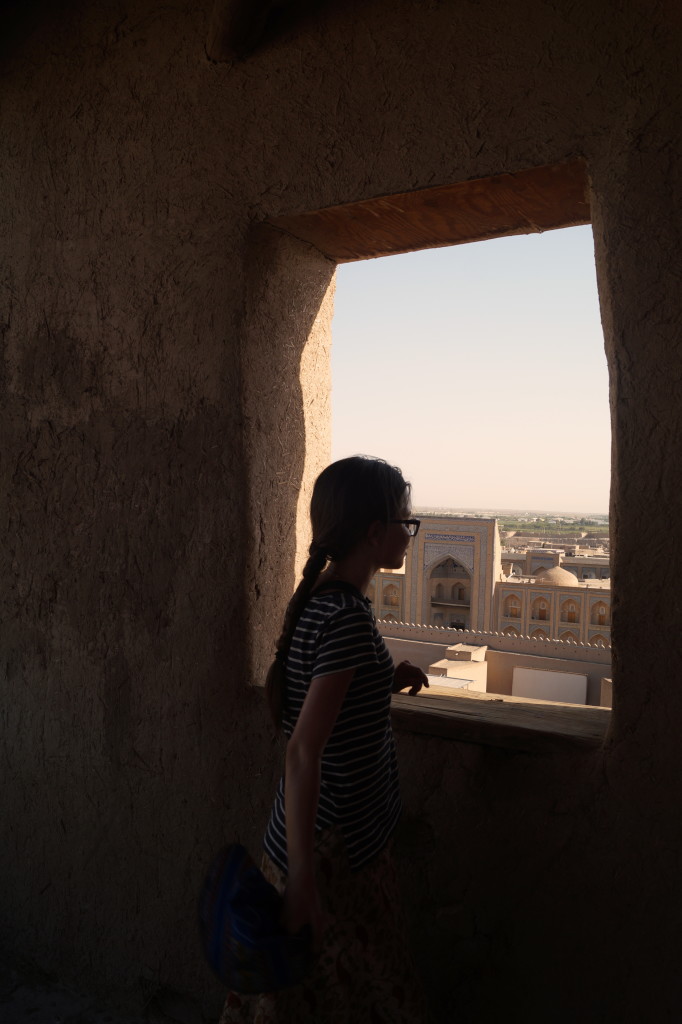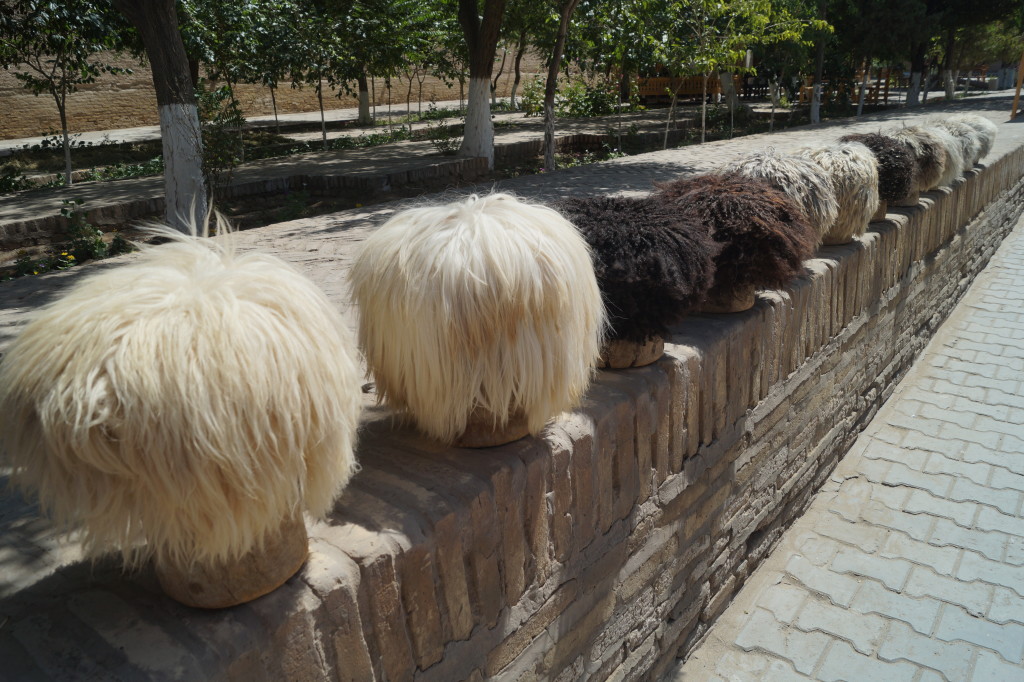 Lucy
Lucy
We entered the 'Stans with high hopes to see beautiful mosques, rugs, architecture and eat interesting foods. We had been studying the Silk Road so we knew about the history. I was hoping to see some camels laden with goods trekking across the desert. I would have loved to see it in its former glory with merchants bargaining in the markets and buying jade, silk, turquoise and carpets. It's called the Silk Road because that was the thing mostly traded with China. We saw some caravanasis where they stayed at night and yurts the official houses of the travelling nomads.

Mummy bought some blue tiles, just like they had on the buildings. They were very pretty, I liked bargaining like a real merchant.
We went to a tea shop where they served nuts, raisins, sweets and tea. I loved the solid crystals of sugar they crunched with a sweet delicious flavour in my mouth.
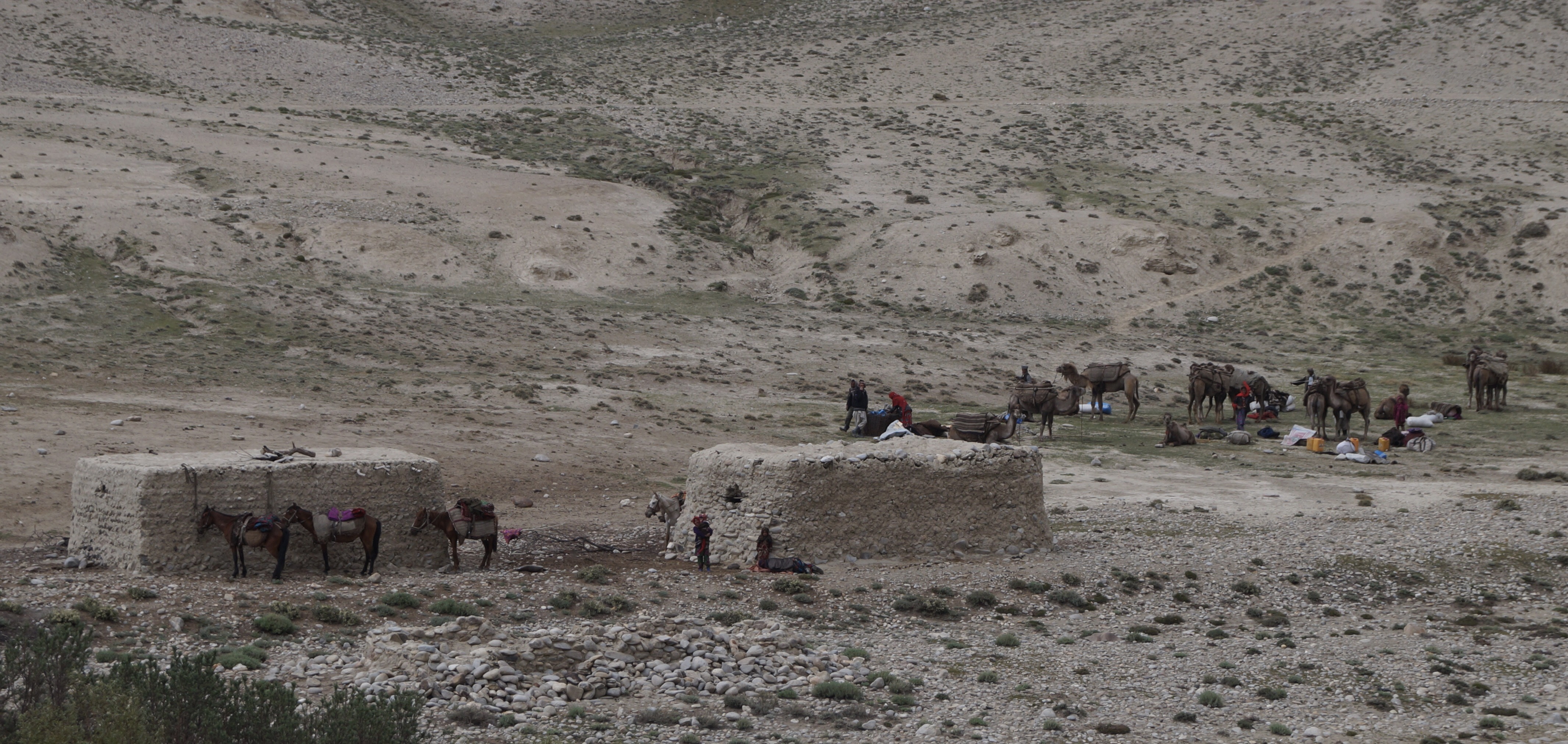
To leave Central Asia we had to cross the sea, I was sad to leave but I always knew we would have new adventures in the next place.
Alisha
From mountains in Kyrgyzstan and Tajikistan to mausoleums in Uzbekistan and deserts in Kazakstan. Central Asia is a riot of culture and traditions that are mixed into their modern lives you see herders with cell phones, yurts with satellite dishes and ancient mosques with security cameras.
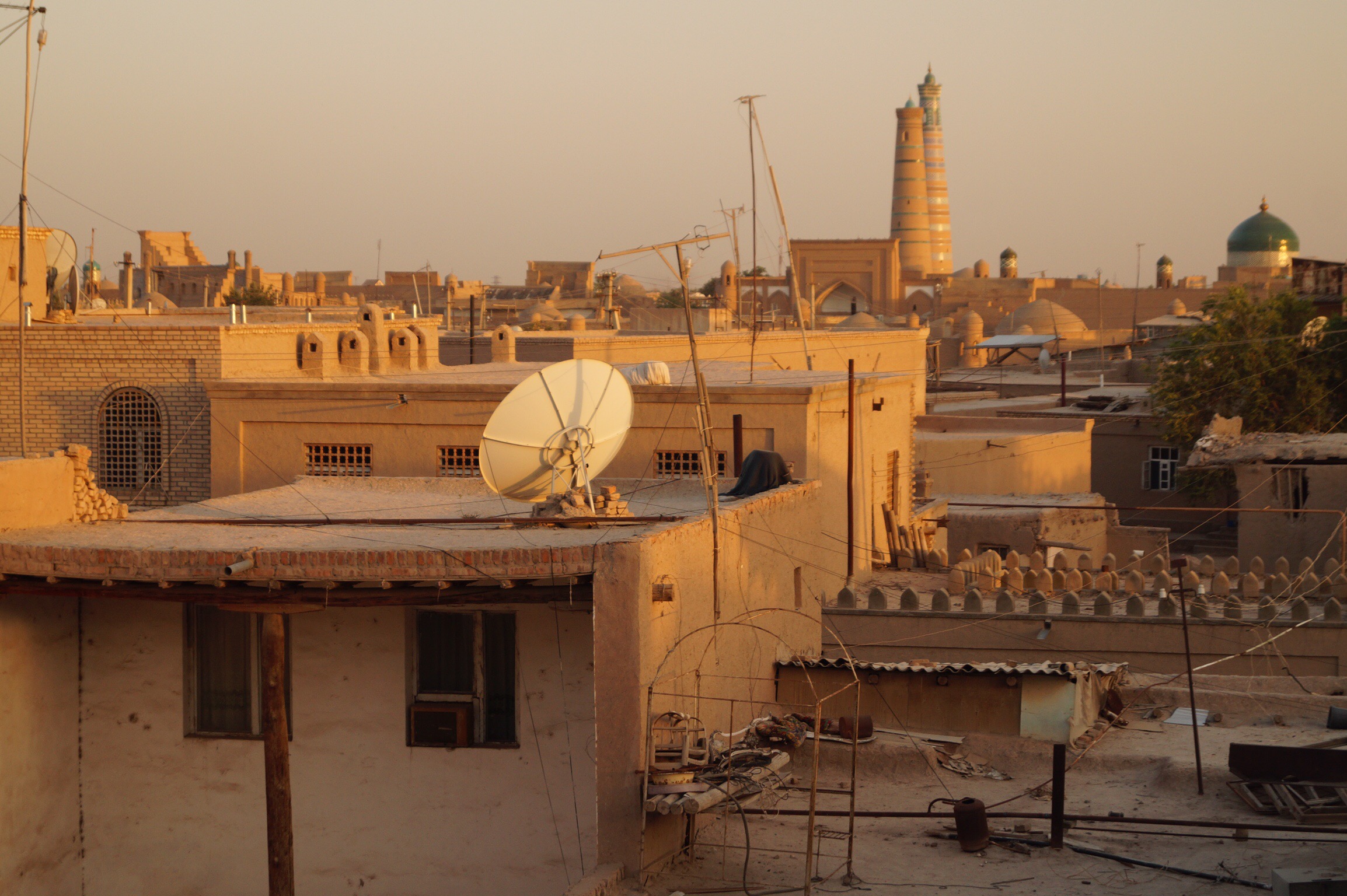
I enjoyed Kyrgyzstan because it was a nice cool place with mountains and difficult roads and just the sort of place strange people like us like to hang out. Tajikistan was much the same, it was funny being a stone's throw from Afghanistan (well a daddy's stone throw, I didn't quite make it). If I had to think of one word to describe Uzbekistan it would be HOT in the truck once it hit 54 degrees. If you want to feel 54 degrees then go into the hottest sauna ever and times the heat by a 100. If you haven't got a sauna then book a flight to Uzbekistan. Kazakstan wasn't so hot which was a relief but it was boring, landscape-wise, at least the bit we traveled through if you show me a picture of a bit we traveled through and a bit we didn't I wouldn't of been able to tell the difference.
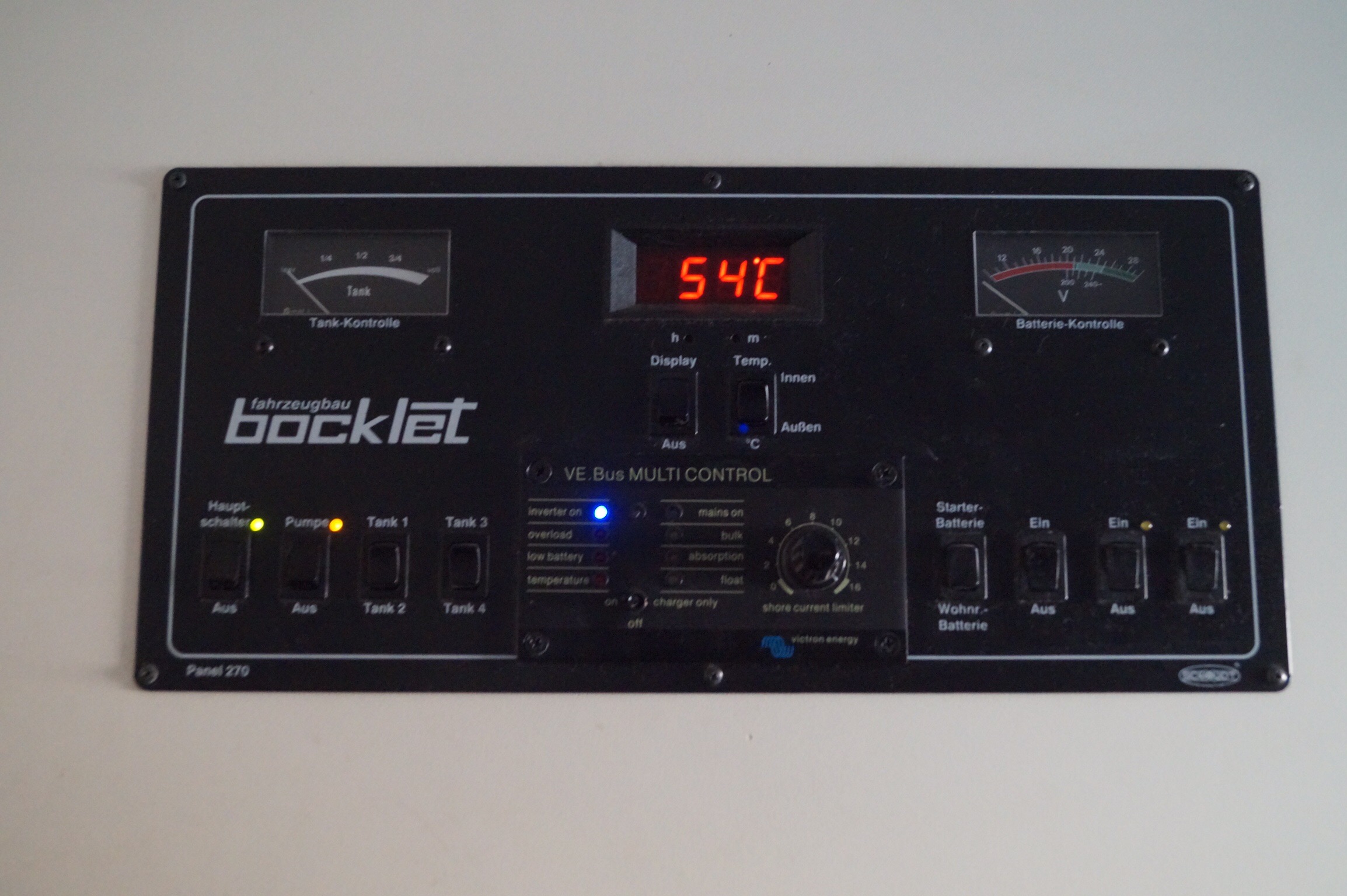
In Uzbekistan I saw a few too many mosques, they where all blue-tiled and had a dome if you seen ten you've seen them all there is absolutely no need to see five million more.
Gilly
Melons are everywhere in Central Asia. Delicious and refreshing and piled up high on every street corner. Flat light bread still warm from the tandoor oven and mutton kebabs, served with salads made for delicious meals, with melon, of course, for desert. The 'Stans' shared Russian heritage made Steve and I nostalgic for our time in Moscow. While I will never enjoy dill liberally sprinkled on every single meal, we did search out some of our old favourite foods. Steve and Alisha embarked on a multinational search for authentic pelmeni (steamed meat dumplings), a mutual passion after sharing many a bowlful when Alisha was little.

Although there is a lot to choose from, I thing for me the highlight was the Pamirs and the Wakhan Valley. Dramatic scenery; snow capped peaks; uninhabited wilderness; right next to a fascinating rogue state (which sadly I am never likely to visit); swollen rivers of snowmelt; and challenging roads made it an unforgettable part of the adventure.
Silk Road cities of Uzbekistan: Samarkand; Bukhara and Khiva all enthralled us with their historical significance and amazing architecture. Whilst I couldn't get enough of turquoise domes and blue tiled arched entrance ways, I could have done without the 45°C heatwave we had whilst we were there.
An unexpected perk of the need to register in a hotel for most of your nights in Uzbekistan (something that was never checked when we left) was meeting other travellers. Since trekking in Nepal, we have met very few other travellers and no other overlanders. Central Asia in the summer is quite popular with independent travellers, motorcyclists and especially long distance cyclists. It was also great to hangout with another overlanding family, our first since Africa, in Samarkand. It was also fun to pair up across the desert with Cate and Michael. At least with the catalogue of minor mechanical problems both the truck and Cate's bike had were easily fixed with many hands.
 Steve
Steve
There was a lot of diversity in Central Asia; from the mountains to the desert, from the cold to the heat, from the unusual to the familiar. After living in Russia many things seemed comfortingly familiar and yet there were also some striking differences. The people were warm and friendly and yet we managed to enjoy lots of time in solitude in beautiful settings.
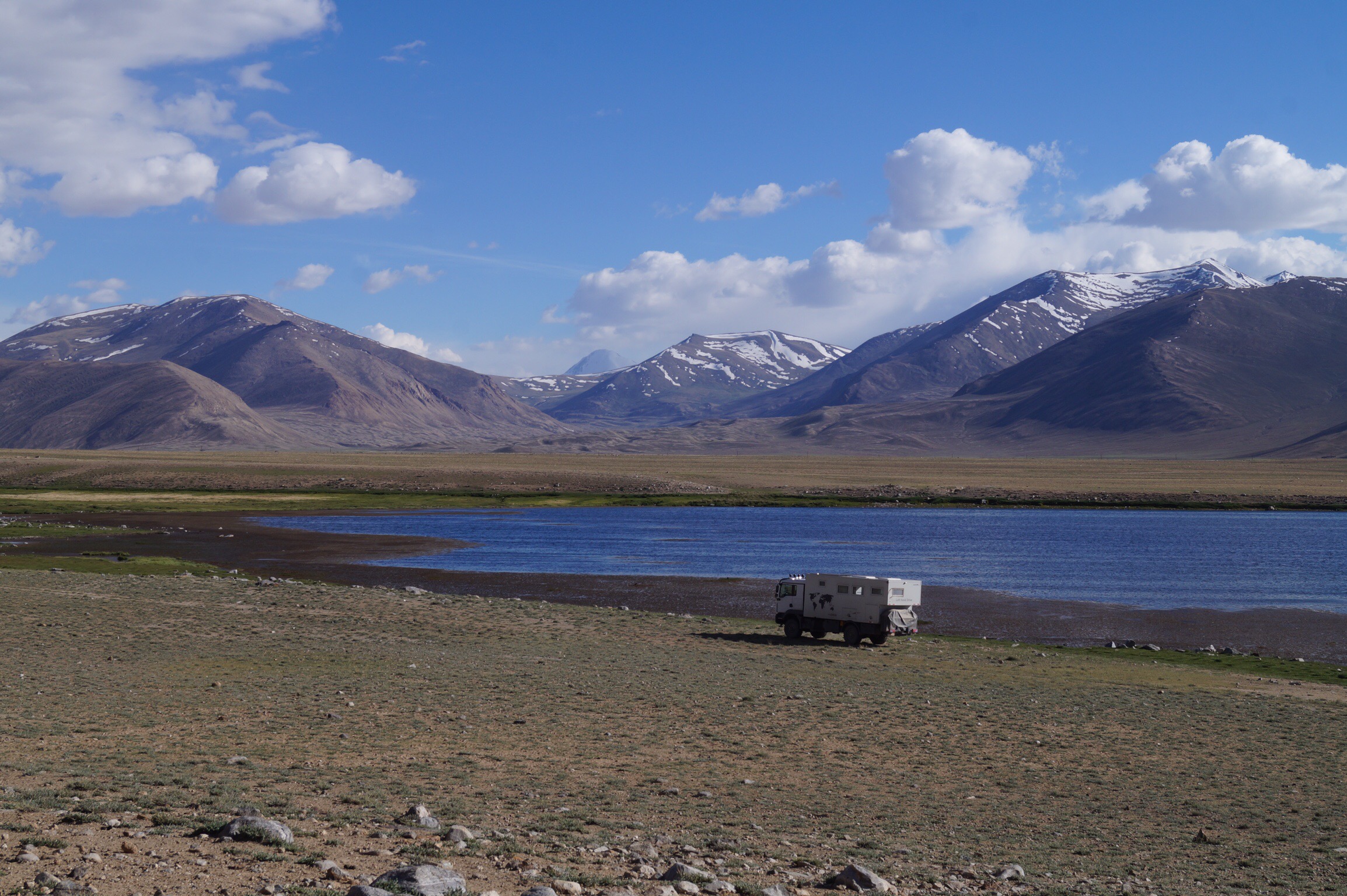
Kyrgyzstan was so green after the starkness of Xinjiang in China. Everywhere we went there was green meadows with running rivers and often the nomads with their yurts and horses camped for the summer. Tajikistan was more stark and rugged but the Pamir Highway and Wakhan corridor were barrenly beautiful with a raging river and pockets of green between it and Afghanistan. Uzbekistan was all about the ancient Silk Road cities. Whilst these have now been spruced up for tourism and at times felt a little soulless there is no denying the eye catching timeless beauty of the monuments. Even in the baking heat we just had to go out and see them again and again.

We did not see a lot of Kazakhstan, mainly desert, but got to to camp there with new friends which was wonderful and saw some amazing sunsets. It was slightly surreal arriving at the Caspian Sea, an oil town and beach resort all rolled into one but one which allowed us a welcome break before the ferry crossing across the Caspian Sea.
Central Asia is a beautiful area of the world rich in diversity. We have met many more overlanders and long term travellers here than in other parts of Asia but it is still largely untouched by mass tourism and you really can get away from it all into areas of natural beauty.
 Lucy
We entered the 'Stans with high hopes to see beautiful mosques, rugs, architecture and eat interesting foods. We had been studying the Silk Road so we knew about the history. I was hoping to see some camels laden with goods trekking across the desert. I would have loved to see it in its former glory with merchants bargaining in the markets and buying jade, silk, turquoise and carpets. It's called the Silk Road because that was the thing mostly traded with China. We saw some caravanasis where they stayed at night and yurts the official houses of the travelling nomads.
Lucy
We entered the 'Stans with high hopes to see beautiful mosques, rugs, architecture and eat interesting foods. We had been studying the Silk Road so we knew about the history. I was hoping to see some camels laden with goods trekking across the desert. I would have loved to see it in its former glory with merchants bargaining in the markets and buying jade, silk, turquoise and carpets. It's called the Silk Road because that was the thing mostly traded with China. We saw some caravanasis where they stayed at night and yurts the official houses of the travelling nomads.
 Mummy bought some blue tiles, just like they had on the buildings. They were very pretty, I liked bargaining like a real merchant.We went to a tea shop where they served nuts, raisins, sweets and tea. I loved the solid crystals of sugar they crunched with a sweet delicious flavour in my mouth.
Mummy bought some blue tiles, just like they had on the buildings. They were very pretty, I liked bargaining like a real merchant.We went to a tea shop where they served nuts, raisins, sweets and tea. I loved the solid crystals of sugar they crunched with a sweet delicious flavour in my mouth.
 To leave Central Asia we had to cross the sea, I was sad to leave but I always knew we would have new adventures in the next place.
Alisha
From mountains in Kyrgyzstan and Tajikistan to mausoleums in Uzbekistan and deserts in Kazakstan. Central Asia is a riot of culture and traditions that are mixed into their modern lives you see herders with cell phones, yurts with satellite dishes and ancient mosques with security cameras.
To leave Central Asia we had to cross the sea, I was sad to leave but I always knew we would have new adventures in the next place.
Alisha
From mountains in Kyrgyzstan and Tajikistan to mausoleums in Uzbekistan and deserts in Kazakstan. Central Asia is a riot of culture and traditions that are mixed into their modern lives you see herders with cell phones, yurts with satellite dishes and ancient mosques with security cameras.
 I enjoyed Kyrgyzstan because it was a nice cool place with mountains and difficult roads and just the sort of place strange people like us like to hang out. Tajikistan was much the same, it was funny being a stone's throw from Afghanistan (well a daddy's stone throw, I didn't quite make it). If I had to think of one word to describe Uzbekistan it would be HOT in the truck once it hit 54 degrees. If you want to feel 54 degrees then go into the hottest sauna ever and times the heat by a 100. If you haven't got a sauna then book a flight to Uzbekistan. Kazakstan wasn't so hot which was a relief but it was boring, landscape-wise, at least the bit we traveled through if you show me a picture of a bit we traveled through and a bit we didn't I wouldn't of been able to tell the difference.
I enjoyed Kyrgyzstan because it was a nice cool place with mountains and difficult roads and just the sort of place strange people like us like to hang out. Tajikistan was much the same, it was funny being a stone's throw from Afghanistan (well a daddy's stone throw, I didn't quite make it). If I had to think of one word to describe Uzbekistan it would be HOT in the truck once it hit 54 degrees. If you want to feel 54 degrees then go into the hottest sauna ever and times the heat by a 100. If you haven't got a sauna then book a flight to Uzbekistan. Kazakstan wasn't so hot which was a relief but it was boring, landscape-wise, at least the bit we traveled through if you show me a picture of a bit we traveled through and a bit we didn't I wouldn't of been able to tell the difference.
 In Uzbekistan I saw a few too many mosques, they where all blue-tiled and had a dome if you seen ten you've seen them all there is absolutely no need to see five million more.
Gilly
Melons are everywhere in Central Asia. Delicious and refreshing and piled up high on every street corner. Flat light bread still warm from the tandoor oven and mutton kebabs, served with salads made for delicious meals, with melon, of course, for desert. The 'Stans' shared Russian heritage made Steve and I nostalgic for our time in Moscow. While I will never enjoy dill liberally sprinkled on every single meal, we did search out some of our old favourite foods. Steve and Alisha embarked on a multinational search for authentic pelmeni (steamed meat dumplings), a mutual passion after sharing many a bowlful when Alisha was little.
In Uzbekistan I saw a few too many mosques, they where all blue-tiled and had a dome if you seen ten you've seen them all there is absolutely no need to see five million more.
Gilly
Melons are everywhere in Central Asia. Delicious and refreshing and piled up high on every street corner. Flat light bread still warm from the tandoor oven and mutton kebabs, served with salads made for delicious meals, with melon, of course, for desert. The 'Stans' shared Russian heritage made Steve and I nostalgic for our time in Moscow. While I will never enjoy dill liberally sprinkled on every single meal, we did search out some of our old favourite foods. Steve and Alisha embarked on a multinational search for authentic pelmeni (steamed meat dumplings), a mutual passion after sharing many a bowlful when Alisha was little.
 Although there is a lot to choose from, I thing for me the highlight was the Pamirs and the Wakhan Valley. Dramatic scenery; snow capped peaks; uninhabited wilderness; right next to a fascinating rogue state (which sadly I am never likely to visit); swollen rivers of snowmelt; and challenging roads made it an unforgettable part of the adventure.
Silk Road cities of Uzbekistan: Samarkand; Bukhara and Khiva all enthralled us with their historical significance and amazing architecture. Whilst I couldn't get enough of turquoise domes and blue tiled arched entrance ways, I could have done without the 45°C heatwave we had whilst we were there.
An unexpected perk of the need to register in a hotel for most of your nights in Uzbekistan (something that was never checked when we left) was meeting other travellers. Since trekking in Nepal, we have met very few other travellers and no other overlanders. Central Asia in the summer is quite popular with independent travellers, motorcyclists and especially long distance cyclists. It was also great to hangout with another overlanding family, our first since Africa, in Samarkand. It was also fun to pair up across the desert with Cate and Michael. At least with the catalogue of minor mechanical problems both the truck and Cate's bike had were easily fixed with many hands.
Although there is a lot to choose from, I thing for me the highlight was the Pamirs and the Wakhan Valley. Dramatic scenery; snow capped peaks; uninhabited wilderness; right next to a fascinating rogue state (which sadly I am never likely to visit); swollen rivers of snowmelt; and challenging roads made it an unforgettable part of the adventure.
Silk Road cities of Uzbekistan: Samarkand; Bukhara and Khiva all enthralled us with their historical significance and amazing architecture. Whilst I couldn't get enough of turquoise domes and blue tiled arched entrance ways, I could have done without the 45°C heatwave we had whilst we were there.
An unexpected perk of the need to register in a hotel for most of your nights in Uzbekistan (something that was never checked when we left) was meeting other travellers. Since trekking in Nepal, we have met very few other travellers and no other overlanders. Central Asia in the summer is quite popular with independent travellers, motorcyclists and especially long distance cyclists. It was also great to hangout with another overlanding family, our first since Africa, in Samarkand. It was also fun to pair up across the desert with Cate and Michael. At least with the catalogue of minor mechanical problems both the truck and Cate's bike had were easily fixed with many hands.
 Steve
There was a lot of diversity in Central Asia; from the mountains to the desert, from the cold to the heat, from the unusual to the familiar. After living in Russia many things seemed comfortingly familiar and yet there were also some striking differences. The people were warm and friendly and yet we managed to enjoy lots of time in solitude in beautiful settings.
Steve
There was a lot of diversity in Central Asia; from the mountains to the desert, from the cold to the heat, from the unusual to the familiar. After living in Russia many things seemed comfortingly familiar and yet there were also some striking differences. The people were warm and friendly and yet we managed to enjoy lots of time in solitude in beautiful settings.
 Kyrgyzstan was so green after the starkness of Xinjiang in China. Everywhere we went there was green meadows with running rivers and often the nomads with their yurts and horses camped for the summer. Tajikistan was more stark and rugged but the Pamir Highway and Wakhan corridor were barrenly beautiful with a raging river and pockets of green between it and Afghanistan. Uzbekistan was all about the ancient Silk Road cities. Whilst these have now been spruced up for tourism and at times felt a little soulless there is no denying the eye catching timeless beauty of the monuments. Even in the baking heat we just had to go out and see them again and again.
Kyrgyzstan was so green after the starkness of Xinjiang in China. Everywhere we went there was green meadows with running rivers and often the nomads with their yurts and horses camped for the summer. Tajikistan was more stark and rugged but the Pamir Highway and Wakhan corridor were barrenly beautiful with a raging river and pockets of green between it and Afghanistan. Uzbekistan was all about the ancient Silk Road cities. Whilst these have now been spruced up for tourism and at times felt a little soulless there is no denying the eye catching timeless beauty of the monuments. Even in the baking heat we just had to go out and see them again and again.
 We did not see a lot of Kazakhstan, mainly desert, but got to to camp there with new friends which was wonderful and saw some amazing sunsets. It was slightly surreal arriving at the Caspian Sea, an oil town and beach resort all rolled into one but one which allowed us a welcome break before the ferry crossing across the Caspian Sea.
Central Asia is a beautiful area of the world rich in diversity. We have met many more overlanders and long term travellers here than in other parts of Asia but it is still largely untouched by mass tourism and you really can get away from it all into areas of natural beauty.
We did not see a lot of Kazakhstan, mainly desert, but got to to camp there with new friends which was wonderful and saw some amazing sunsets. It was slightly surreal arriving at the Caspian Sea, an oil town and beach resort all rolled into one but one which allowed us a welcome break before the ferry crossing across the Caspian Sea.
Central Asia is a beautiful area of the world rich in diversity. We have met many more overlanders and long term travellers here than in other parts of Asia but it is still largely untouched by mass tourism and you really can get away from it all into areas of natural beauty. 
